Cartier
The Cartier Tank Cintrée — A Complete Guide
Cartier
The Cartier Tank Cintrée — A Complete Guide
Cartier then commercialized this timepiece in 1911 and so began the legend of his revolutionary watch designs. But the Tank Cintrée was the most iconoclastic of his creations. It broke with every rule in conventional watch design. It followed on the path blazed by Cartier’s Tank.
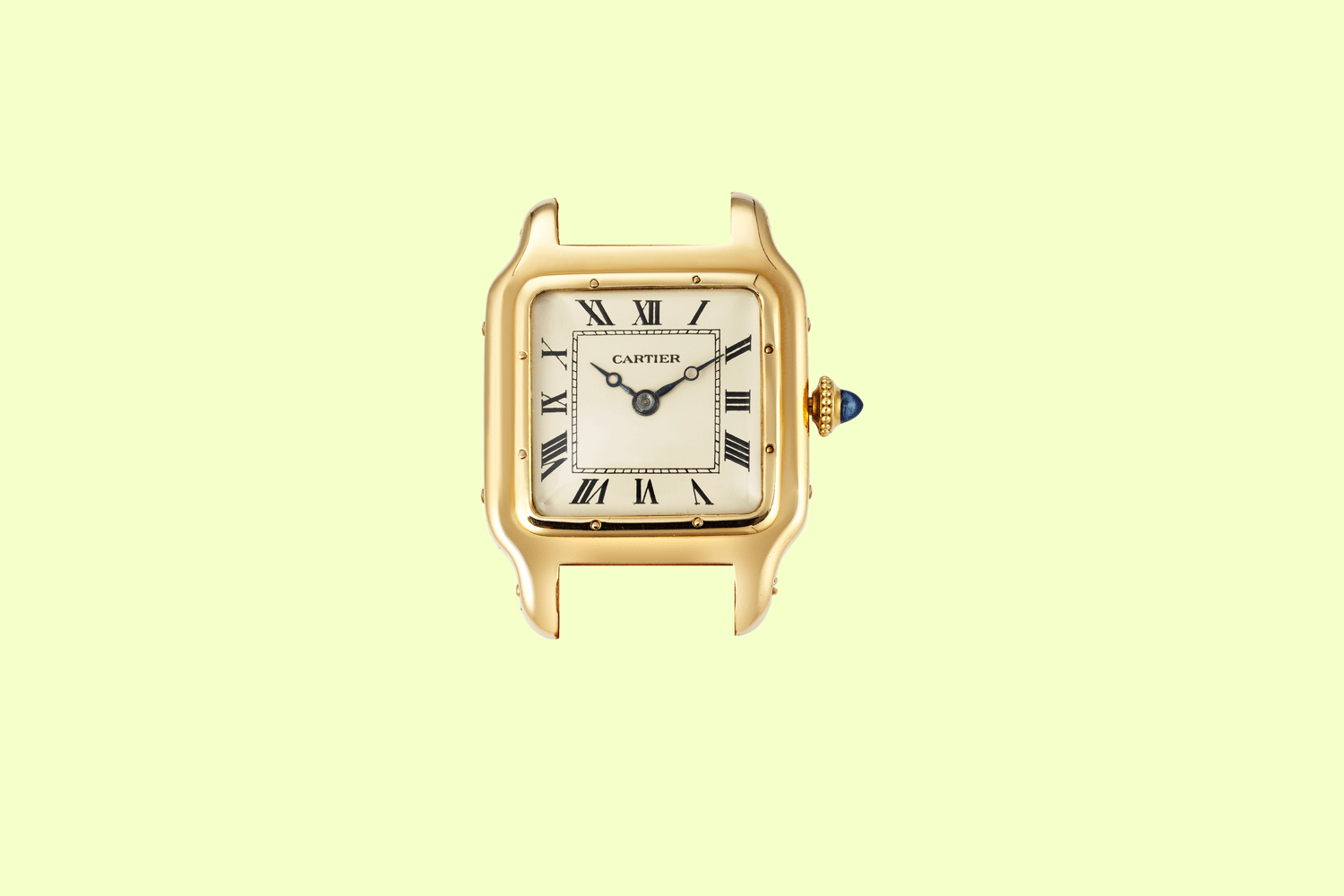
Created specially for his friend the aviator Alberto Santos-Dumont, who wanted to tell time easily while flying, the Santos wristwatch symbolizes Louis Cartier’s visionary approach. Louis was convinced that this accessory should be worn on the wrist. A certainty he was the first to promulgate forty years ahead of anyone! Pocket watches disappeared only in the mid-1940s. Santos-Dumont wristwatch Cartier Paris, 1912 Yellow gold, pink gold, One sapphire cabochon, Leather strap. Dimensions of the case: 3.42 x 2.48 cm. Studio Gérard © Cartier
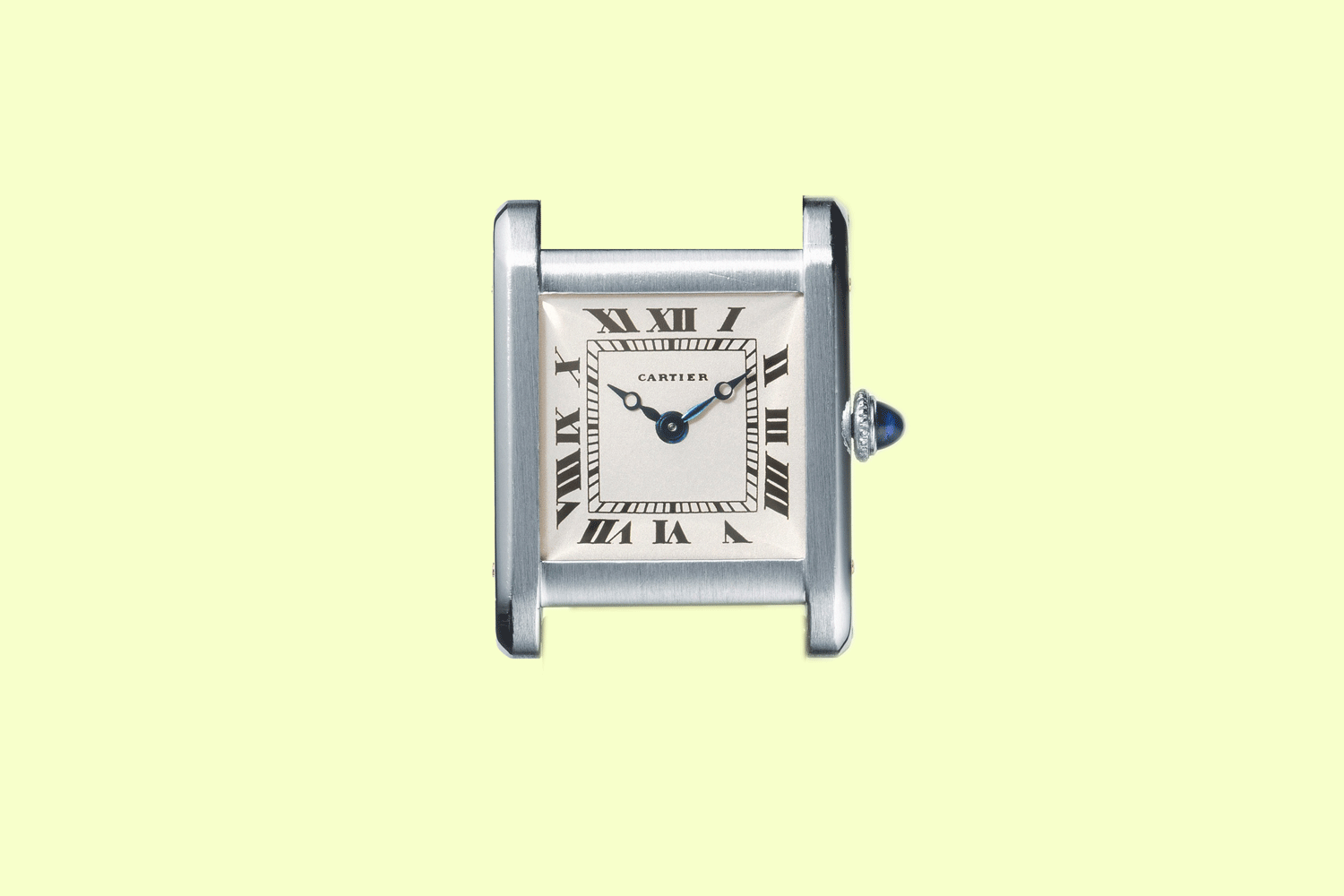
Conceived by Louis Cartier, the Tank wristwatch embodies the perfect balance between classicism and modernity. Here, function becomes form. The hours are written in Roman numerals, as in clocks of the 17th century, while the square-shaped dial is thoroughly contemporary. The Tank watch is timeless, and its success constant and universal. The biggest Hollywood stars, such as Rudolph Valentino and Gary Cooper, and the most elegant ones, like Catherine Deneuve, wore it as a statement of style and freedom. Tank wristwatch Cartier Paris, 1920 Platinum, gold, One sapphire cabochon, Leather strap. Dimensions of the case: 2.96 x 2.30 cm. © Cartier
A Revolutionary Watch
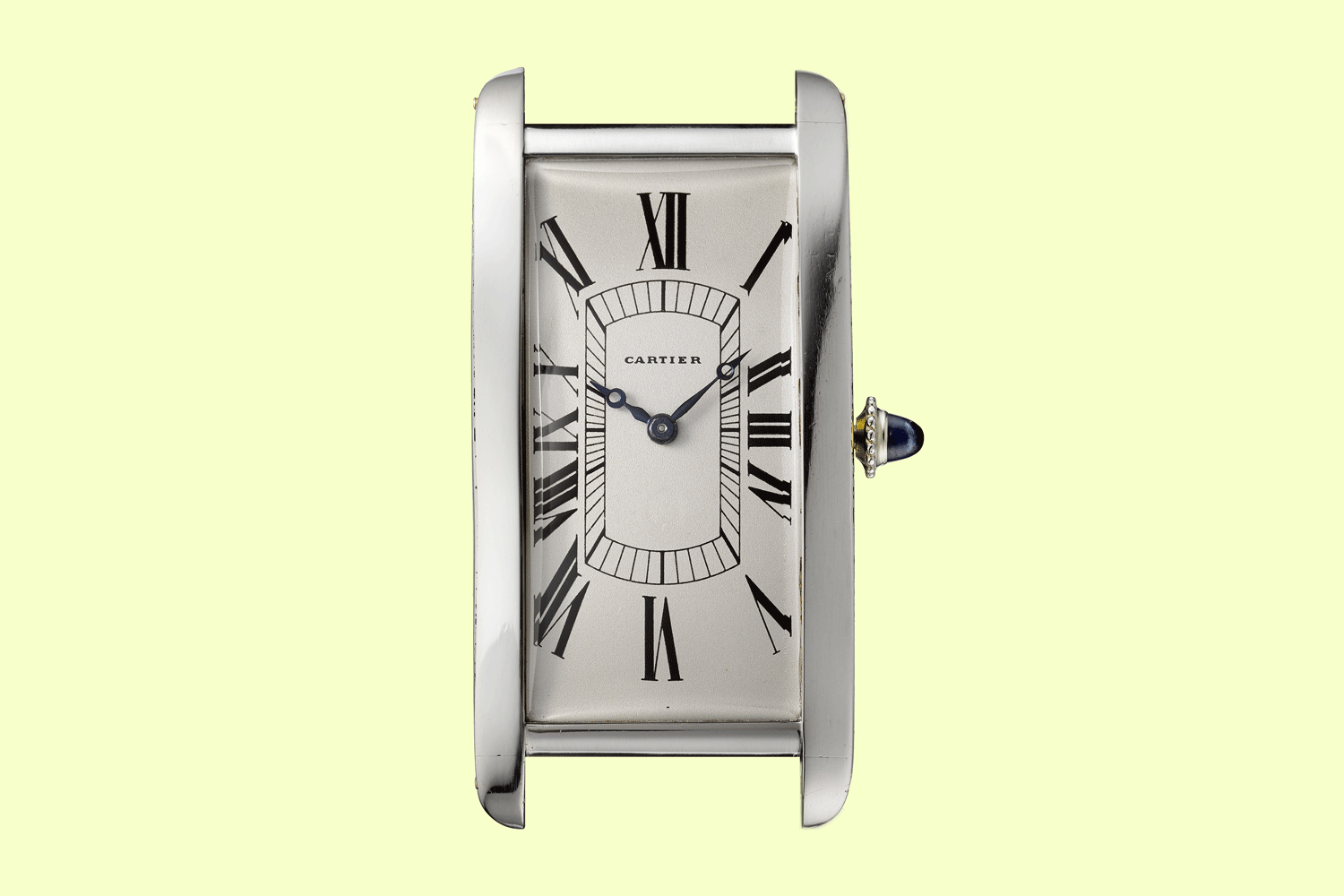
An exemplary Tank Cintrée Wristwatch from 1924; platinum, yellow gold, one sapphire cabochon, leather strap; round LeCoultre calibre 123 movement, Côtes de Genève decoration, rhodium-plated, 8 adjustments, 18 jewels, Swiss lever escapement, bimetallic balance, Breguet balance spring; 4.63 x 2.30 cm (case) © Cartier
But little did the writer understand that the wristwatch had already been adopted by British soldiers fighting in the Boer War. These soldiers understood that there was nothing less practical than trying to extract your pocket watch while returning enemy fire. The First World War completely changed the perception of the wristwatch. US signal officers were actually required to wear wristwatches. Officers in trenches used wristwatches to coordinate attacks over the resounding din of the modern war machine where voice commands could no longer be heard.
Watch brands quickly responded by making various forms of trench watches usually featuring hinged guards that covered the watch’s delicate mineral glass crystals. Following the end of the war, men irrevocably shifted to wristwatches. But all of these timepieces still borrowed their iconography from pocket watches.
Not so with Cartier. Says Cartier collector and renowned author Nick Foulkes, “In the context of the early 20th century, almost everyone is adapting pocket watches to wristwatches. Louis Cartier decided to blaze a different path. He uses all his design acumen and ability to create watches intended for the human wrist and that look beautiful against the background of our corporeal architecture. The Tank Cintrée takes this idea to the extreme in that, for the first time, the case is curved to echo the shape of the wrist. You must understand that in 1921 this was absolutely radical.”
Indeed, Louis Cartier’s brilliant Tank Cintrée featured ravishing new modern design, put for the first time in a wristwatch with a lithe, attenuated compound curved shape that the world had never seen. Foulkes continues, “To me this was Louis Cartier creating something that only he could design. It was so provocative and so audacious. This curved and incredibly thin shape begged the question, but how is it possible to place a movement inside this case?”
Says the legendary Franco Cologni in his book The Cartier Tank Watch, “Once wristwatches began to be released in the 20th century, this structural modification to the case would continue to be explored for ergonomic reasons. Watches needed to fit the curve of the wrist. Cartier has already done such experiments with the Tonneau in 1906. The new shape fit well… with the idea of bending the case, to curve it slightly to show that it was designed to be worn on the wrist. At the time of the Tank Cintrée, this natural curve was indicative of an advancement in style, demonstrating that watchmaking was still a vast field to be explored.”
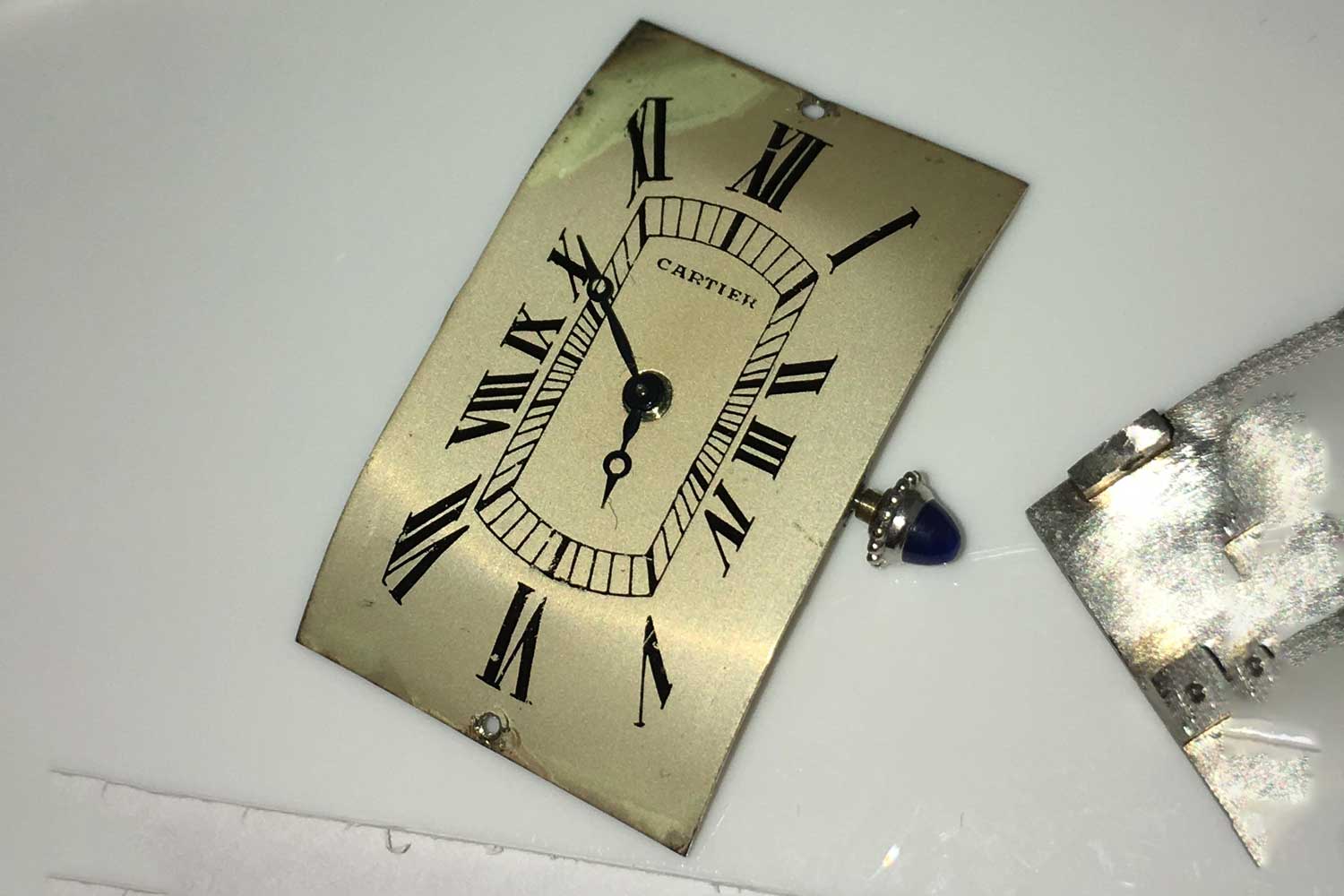
An uncased dial of a circa 1930s Tank Cintrée showcasing its curved surface © bonhams.com
Clearly if you were an individual for which aesthetics beginning with your personal bella figura were important, you could have no other watch than the Tank Cintrée. When Steve McQueen conceptualized the appearance of Thomas Crown, the famous criminal mastermind and playboy, he picked three-piece suits replete with double-breasted waistcoats and fishtail cuffs made by Douglas Hayward and a Cartier Tank Cintrée. Says famed watch collector Ahmed “Shary” Rahman, “Because the focus of Tank Cintrée was so purely aesthetic, it resonated with the type of individual that is obsessed with living a life of perfect aesthetics. It is the ultimate watch for what the French call a boulevardier or flaneur whose primary interest in life is surrounding himself with beauty. To me this message is still as powerfully encoded in the watch today.”
Stylish Cartier Patrons

Ralph Lauren at his Bedford, NY estate with his Cartier Tank peeking out from under his jacket sleeve (Image: Bruce Weber, 1998)

Steve McQueen wearing the Cartier Tank Cintrée in a promotional photo for the Thomas Crown Affair
In order to make the watch function, Cartier had to source a very special movement. For this, he tapped the brilliance of his friend Edmond Jaeger, who was himself a dynamic watchmaking entrepreneur. Jaeger designed an incredibly thin movement to make the design possible. In Cartier-speak, it is the caliber 123. It is round in shape and features 18 jewels, a Swiss lever escapement and a Breguet overcoil hairspring. But if you look at how it sits just behind the curved dial of the Tank Cintrée, you can see that there is barely a fraction of a millimeter to spare as it nestles inside the aggressively curved case. Later, Cartier and Jaeger would create the European Watch and Clock Company as the movement maker for Cartier’s watches and so many of the calibers in the Tank Cintrée are signed with the acronym EWC.
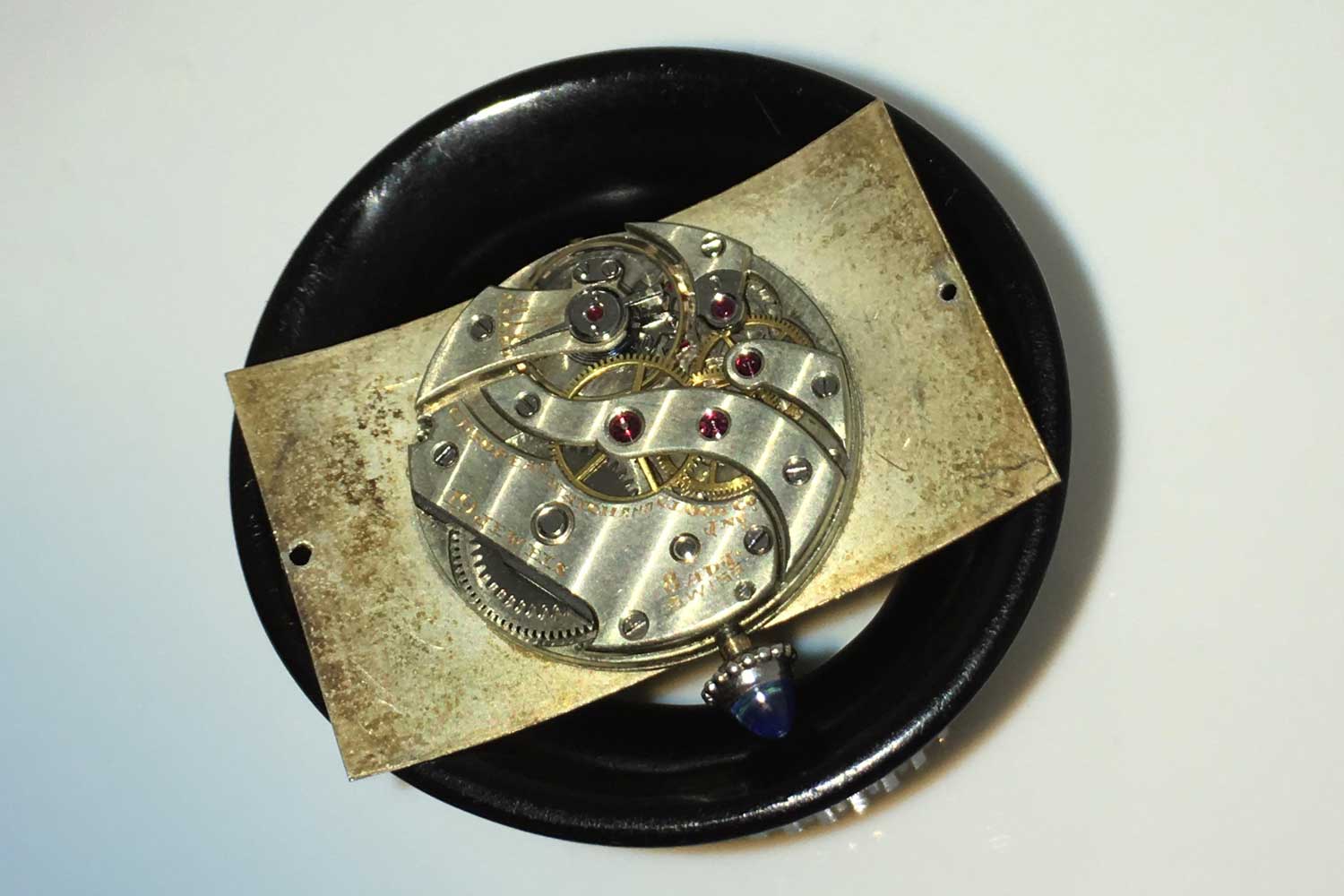
The underside of the circa 1930s Tank Cintrée showing how the movement is placed in the recess of the curve of the watch's dial © bonhams.com
The Tank Cintrée’s iconography was closely aligned with that of the “Tank Normale.” Its dial was devoid of any distracting seconds hand. It featured the same chemin de fer or railroad track for the minutes found on the Tank. But here we see a significant departure from the normal Tank in that the track arches out in a curve from 10 to 1 and again from 5 to 7, echoing the theme of maximum sensual curvature and also helping to fill the space between the indexes and case in this longer, more rectangular watch. Indexes took the form of stunning elongated Roman numerals and the watch featured Breguet hands. If you have never looked closely at the Roman indexes of a Tank Cintrée, I beg you to do so. Look, for example, at the sharp angle formed by the feet of the seven o’clock index to match the corner of the minute track; it is a work of majestic typographical beauty. It is representative of the Art Deco era which was at the height of its influence at the time.
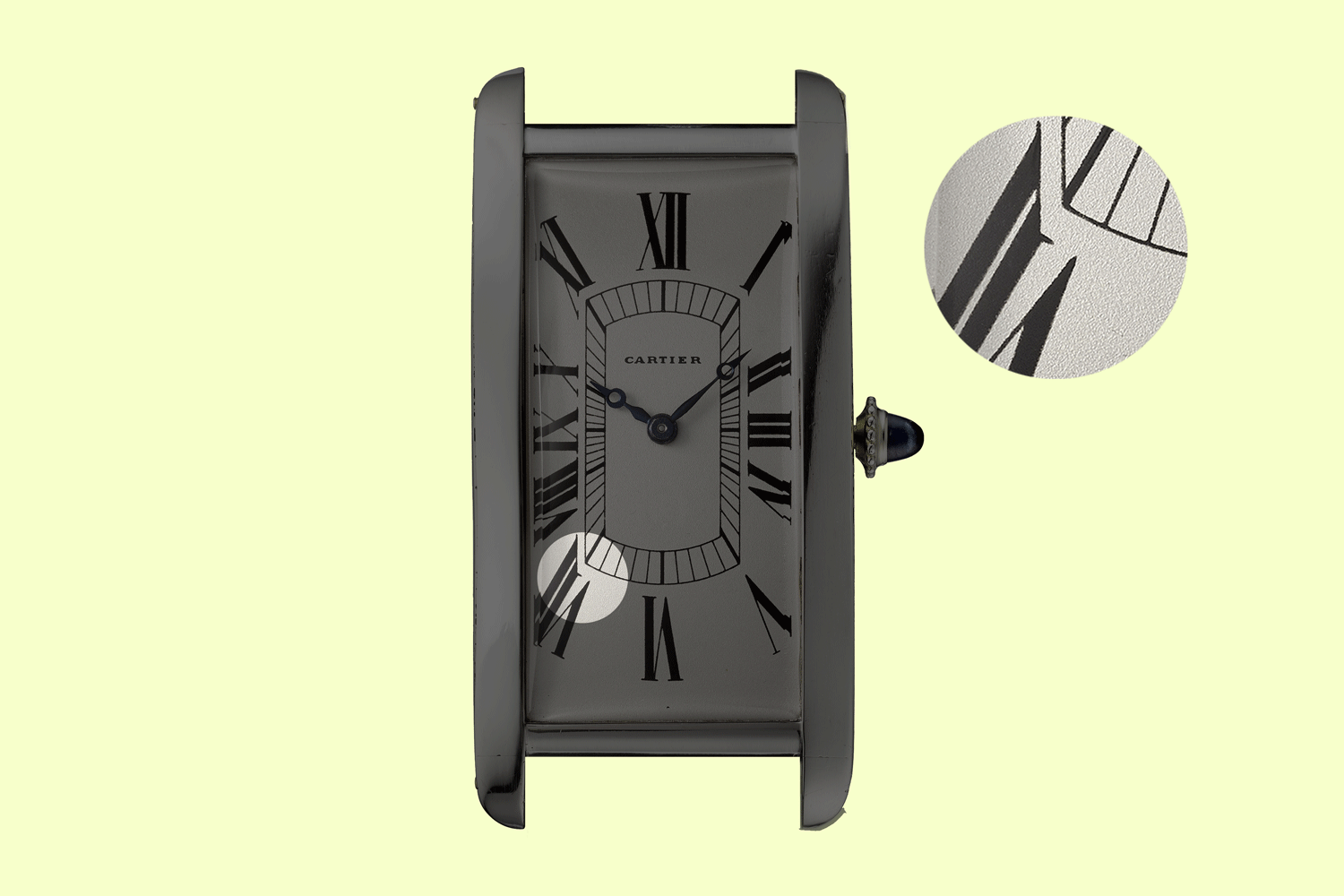
The sharp angle formed by the feet of the seven o’clock index to match the corner of the minute track is a work of majestic typographical beauty on the dial of the Cartier Tank Cintrée (©Revolution)
Says renowned watch collector and Cartier expert Auro Montanari, “Another radical aspect of the Tank Cintrée is the size of the watch in the context of the 1920s. It can only be described as massive.” Indeed, the case was mind-blowingly large in the context of the era, measuring a full 44.7mm in length and 23mm in width. The watch also measured a slim 6.7mm in thickness, though this is only at one point in line with the crown, while the rest of the watch is much slimmer due to its curved profile. The overall effect was as if Raymond Loewy, the father of streamlined design, had consulted with Cartier on transforming this Art Deco masterpiece into a shimmering symbol of modernism for the new century. And that was precisely the point of the Tank Cintrée. It created the ultimate rift with the past and was the first true horological design revolution of the 20th century.
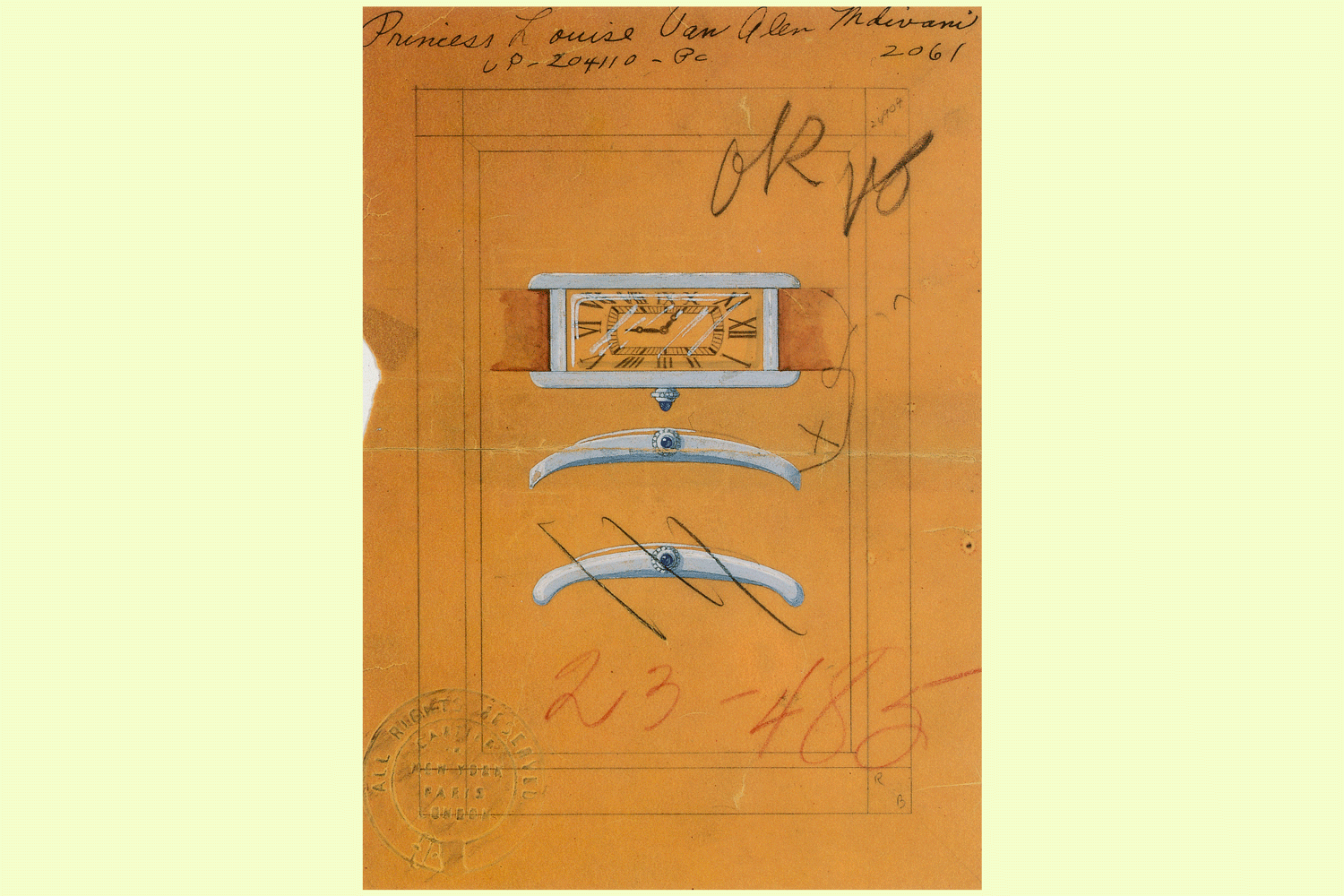
Drawing for a Tank cintrée wristwatch made for Princess Mdivani, born Louise Van Alen, Cartier New York, 1935 (©Cartier)
The world saw large-scale modernization as telephones, automobiles and aviation became commonplace. People were connected like never before. Cinema reached a zenith of popularity, radios permeated every home, jazz emerged as an original art form, Tamara de Lempicka, Edvard Munch and Salvador Dali revolutionized painting, Prohibition in the United States led to the rise of the American gangsters while enormous fortunes such as that of Joe Kennedy were made through bootlegging, and F. Scott Fitzgerald released the seminal novel of the era, The Great Gatsby. Into this chrysalis of change the Tank Cintrée was born and soon became the symbol of this thrilling modernism.
Recently, the horological website A Collected Man published an extremely good article: “100 Years of the Cartier Tank Cintrée.” In this, the author identifies three sizes for the Tank Cintrée which he classifies according the sizes of the movements, which are 7, 8 and 9 lignes. Lignes are a unit of measurement for watch movements with one ligne equaling 2.25mm or 1mm being the equivalent of 0.44 lignes. The largest 9-ligne movement is featured in vintage watches with cases that are up to 46.5mm in length.
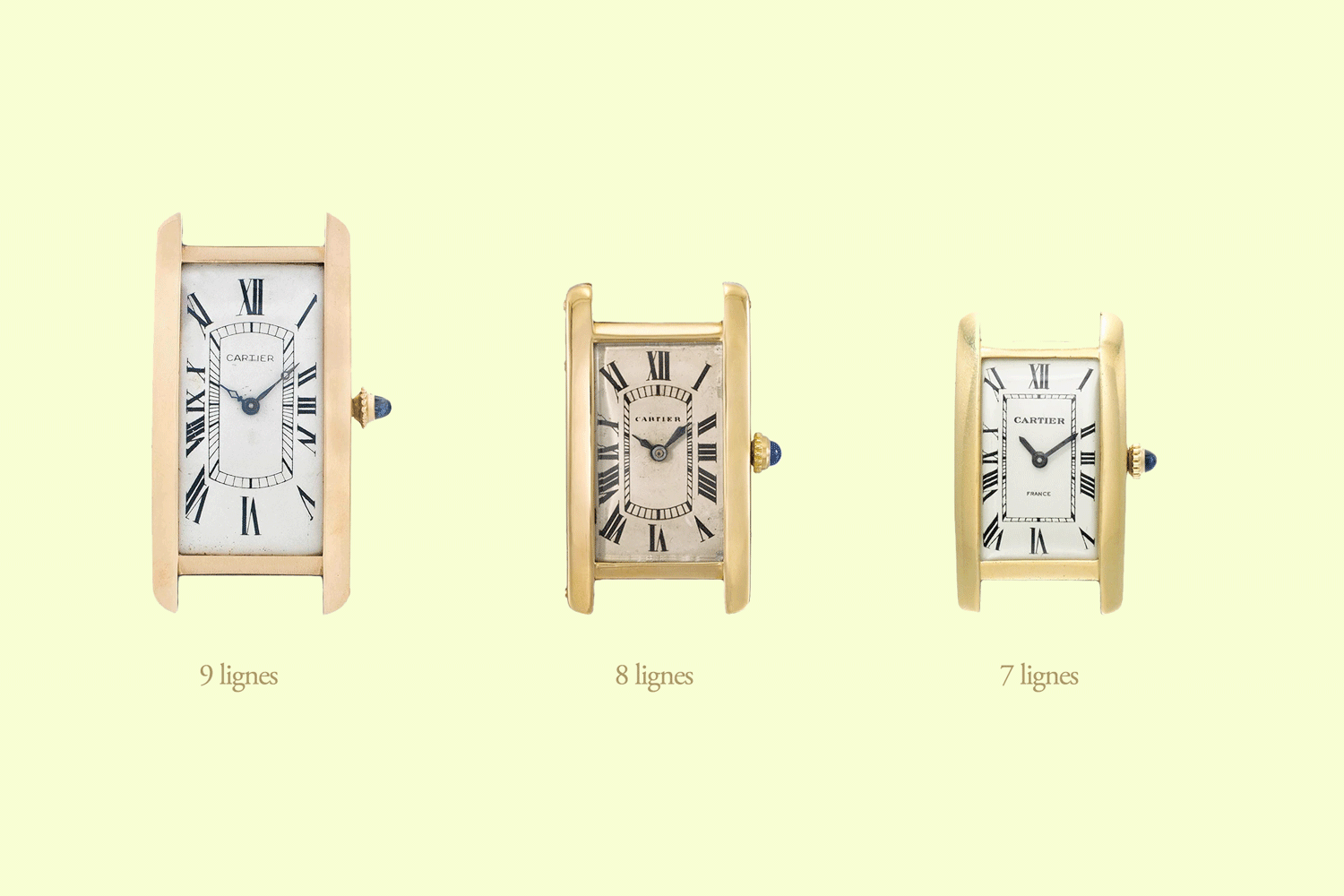
Lignes are a unit of measurement for watch movements with one ligne equaling 2.25mm or 1mm being the equivalent of 0.44 lignes; modern scholarship suggests that the Tank Cintrée was made in three size variations, as seen above for comparison, determined by the movement sizes used within (Graphic recreated from acollectedman.com)
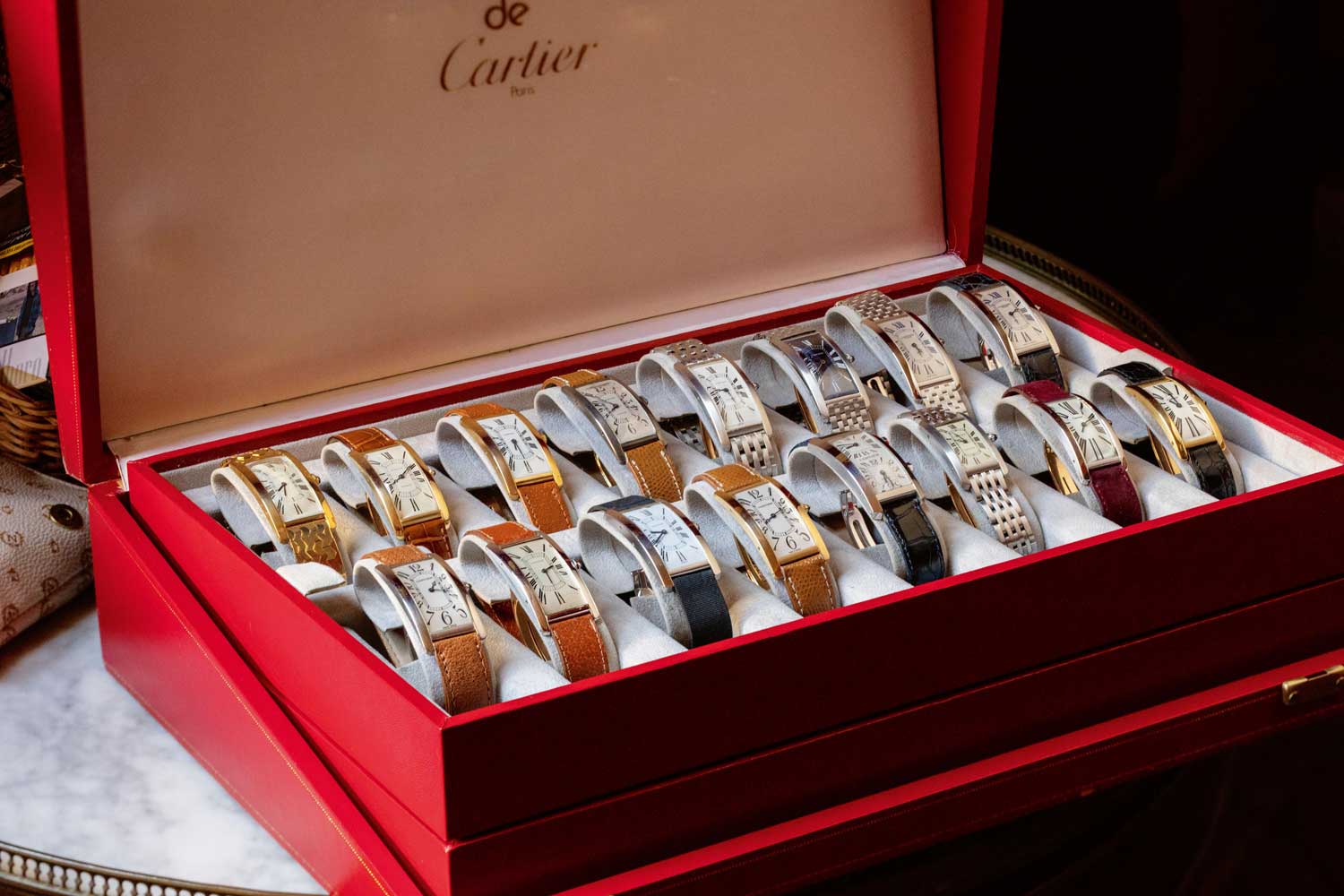
Some of Auro Montanari’s Tank Cintrées, in a Cartier box, showing the evolution of the watch line (©Revolution)
OK, as the secondary prices of even more recent limited-edition Tank Cintrées are now reaching truly staggering heights, the purpose of this article is to give a full overview of the 100-year history of this iconic timepiece, and some understanding of the collectability of each key reference. People often ask me what watches I think will be future collectables and my response is modern Cartiers, in particular iconic shapes and references such as the Tank Cintrée.
Dial Designs
Over the history of the Cartier Tank Cintrée, there have been three major designs for the dial. These are as follows:
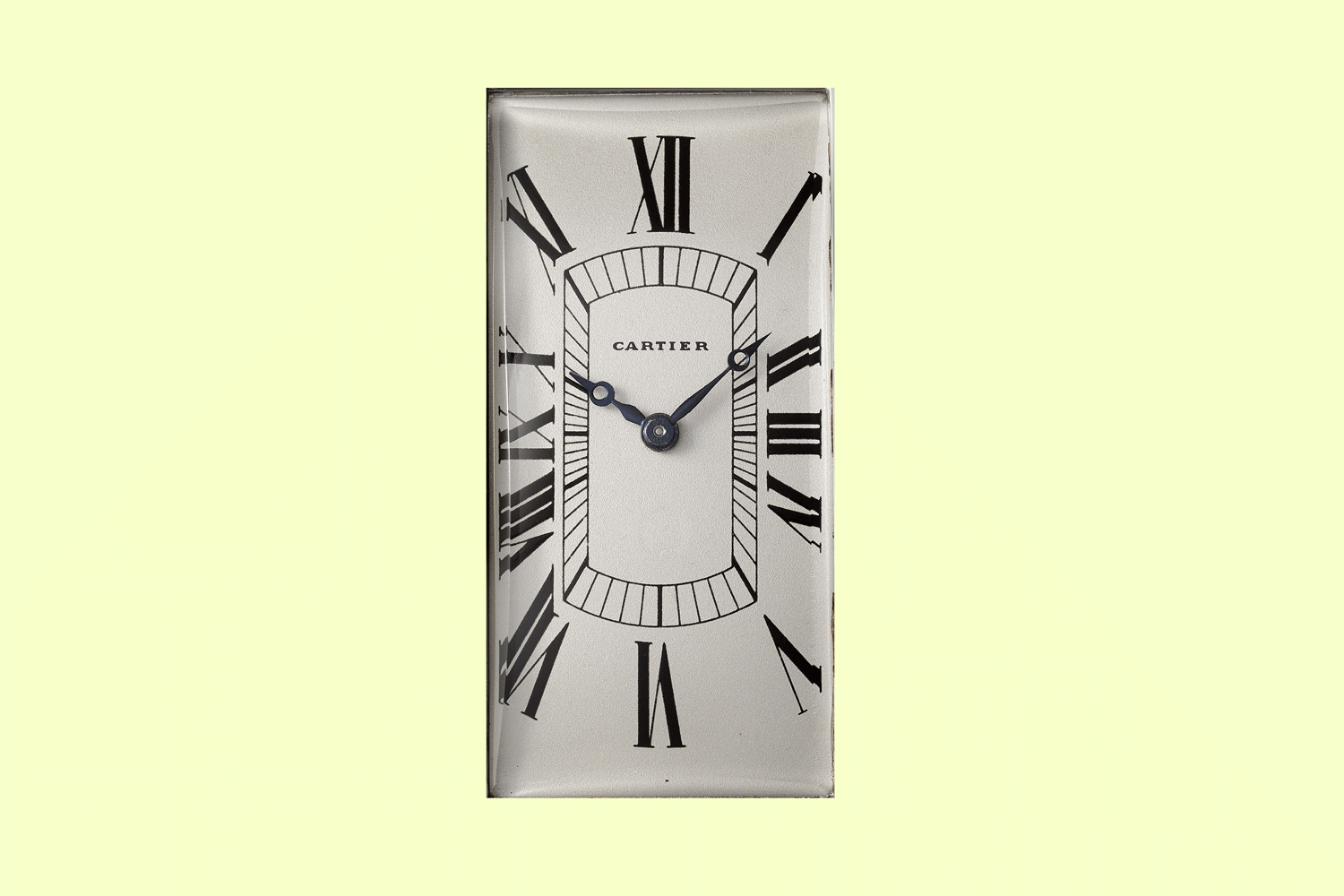
Dial with Roman Numerals and Chemin de Fer Minute Track (©Revolution)
There is some discussion over the length of these Roman indexes and how they appear more stretched and elongated in some examples, and less so in others. To me this is actually related to the size of the watch, rather than variations in indexes. Smaller watches such as the pieces with 7- or 8-ligne movements will have shorter indexes while the larger size 9-ligne movement watches will have longer indexes — another factor supporting Montanari’s particular affection for the latter timepieces.
One thing that I love about the dial of the Tank Cintrée is that the iconography almost appears to be hand drawn. Even the Cartier signature seems signed by hand. This is particularly true for vintage watches from the ’20s all the way through to the ’70s. After that, most likely because of a more industrialized approach to production, the modern dials sometimes have a less hand-drawn feel to them. But I hope Cartier brings this back as I find it enormously appealing, especially in an era where perfection is a bit too commonplace.
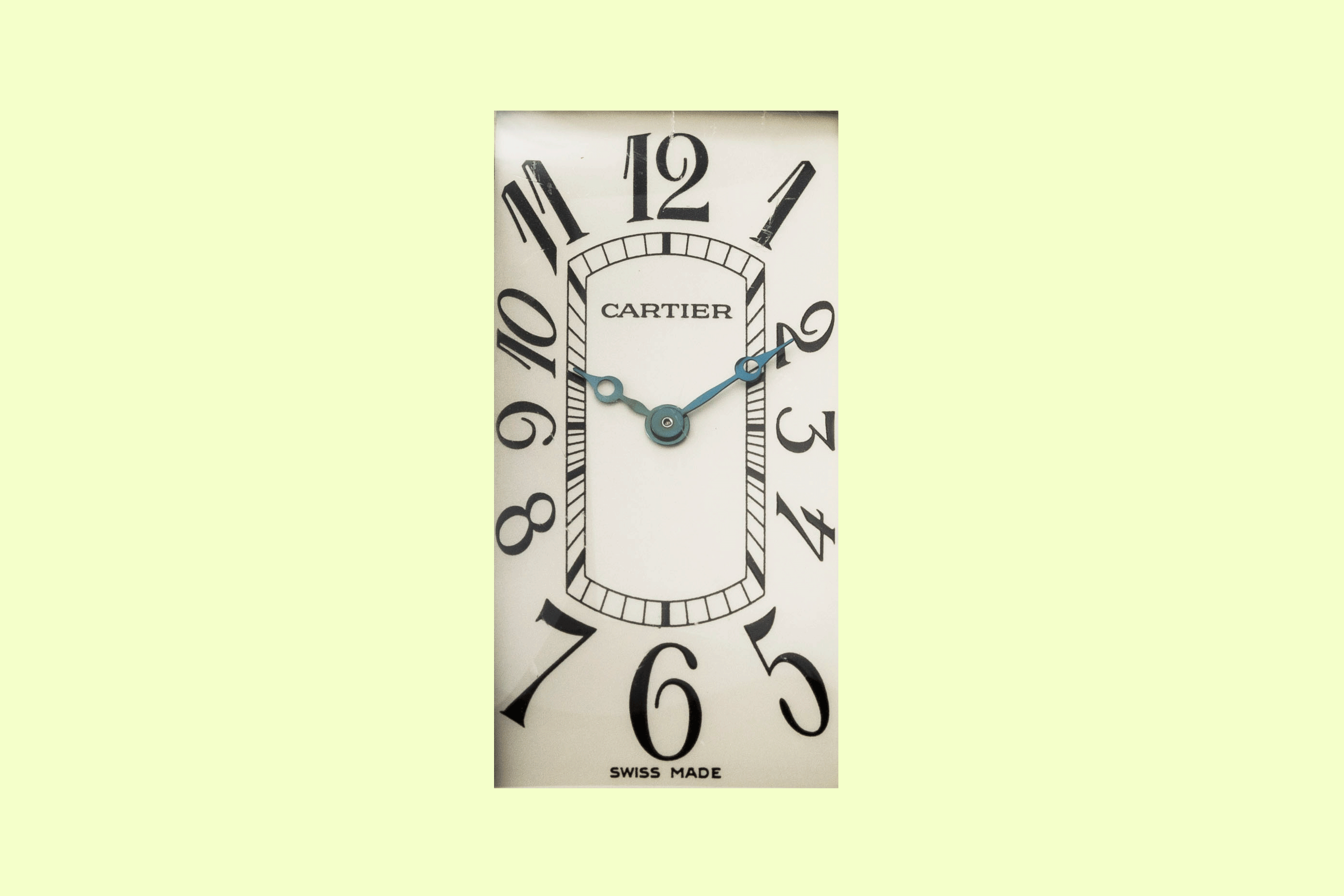
Dial with Arabic Numerals and Chemin de Fer Minute Track (©Revolution)
As far as I know, this was the first time Arabic numerals and hands of this style appeared on a Tank Cintrée. While there is speculation that “a few” such Tank Cintrées were made, I have never seen any other example beyond this. Because of its near-mythological, unicorn-status fame, the Fred Astaire Tank inspired the creation of the aforementioned 2004 limited edition; however, it should be noted that while the new watch featured Arabic indexes, they were not luminous. Also, instead of cathedral hands, both executions of the watch featured flame-blued Breguet hands.
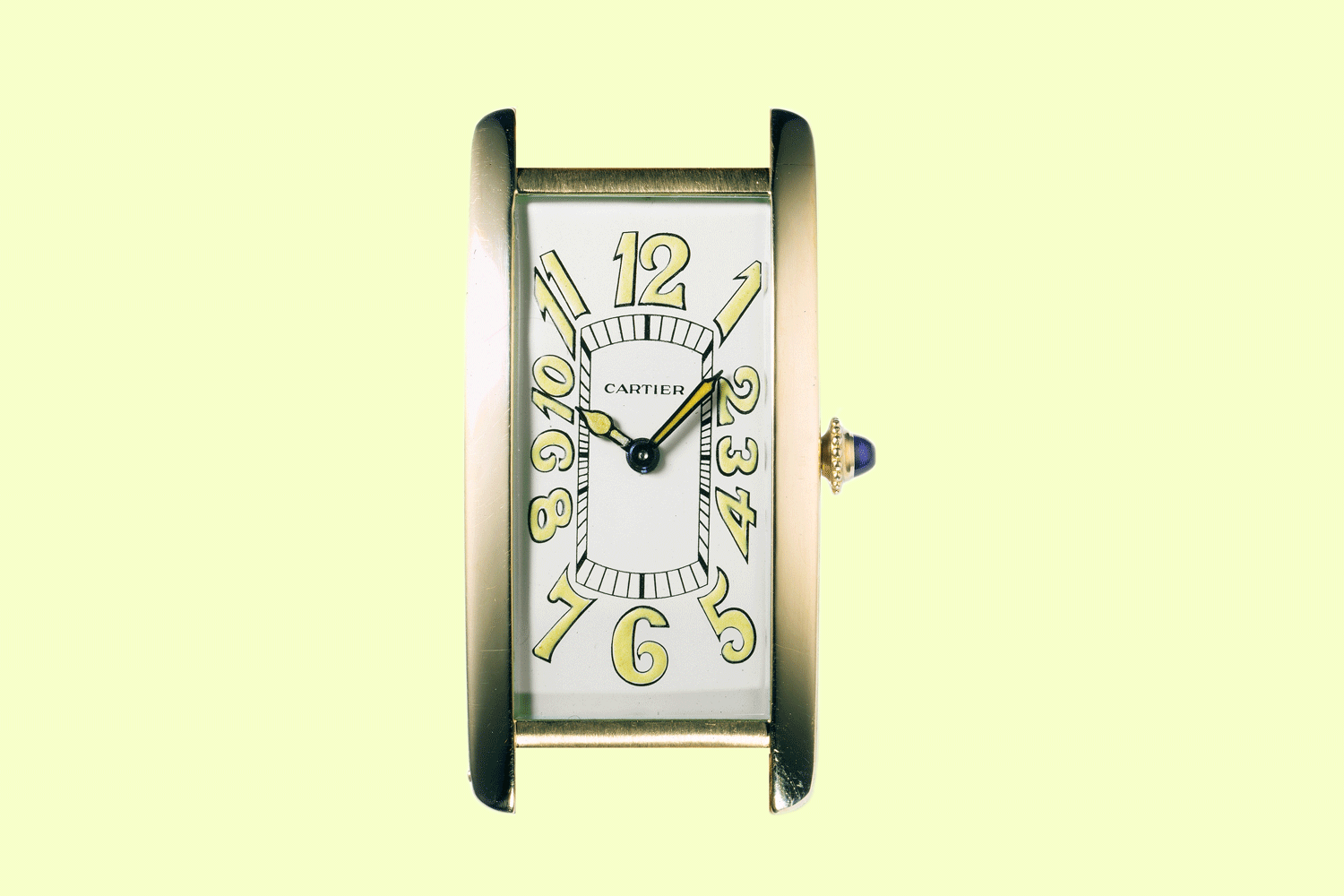
The Tank Cintrée by Cartier London, dated to 1929 and gifted by Fred Astaire to his friend and racehorse trainer Felix Leach Jr, which had a dial with a combination of Arabic Numerals and chemin de fer minute track; this watch is presently part of the Cartier Collection (©Revolution)
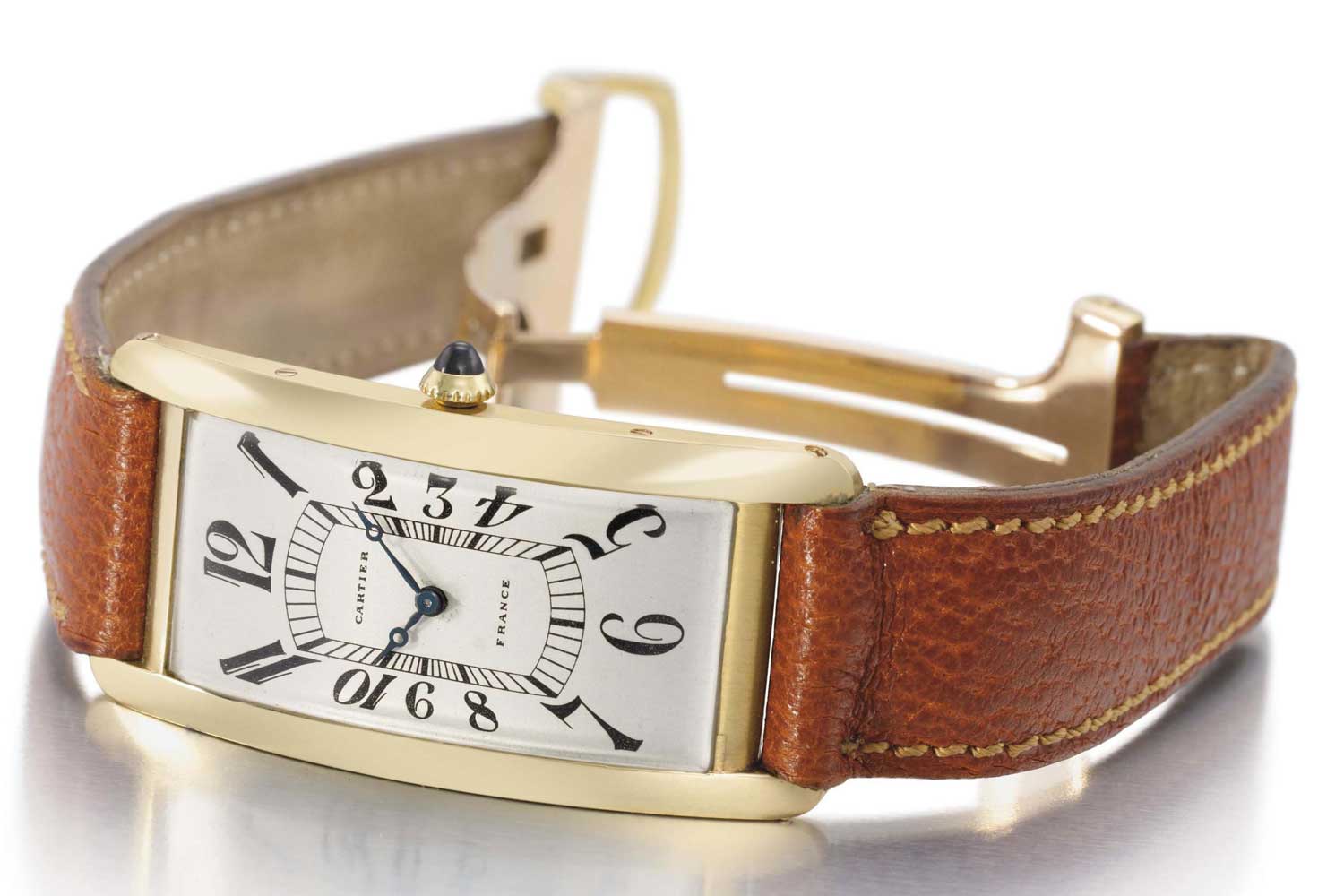
An anomaly of sorts, a Tank Cintrée with Arabic numerals and chemin de fer minute track, case stamped EJ and numbered 21082, 1246 and 27631, movement signed European Watch and Clock Co. Inc., inside case stamped JC and with Glasgow import letter for 1936; sold by Christie's in 2011 for CHF 32,500 (Image: christies.com)
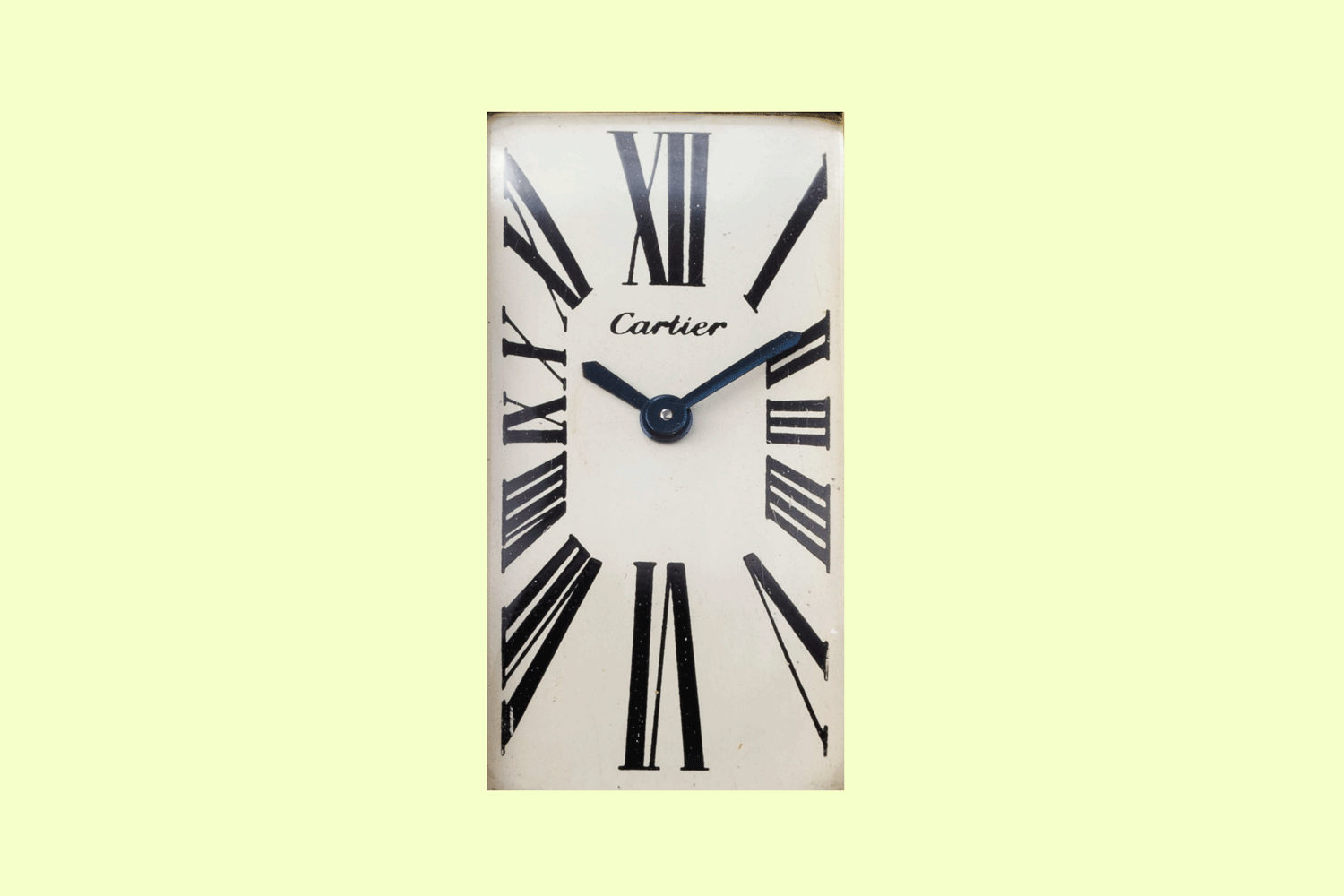
Stretched Roman Numerals without Minute Track (©Revolution)
To borrow from Montanari’s Brâncuși analogy, here the radical elongation of these indexes results in an evocation of velocity as if the numerals which emerge from the center of the watch are racing to the edge of the case. The effect is truly marvelous and creates a visceral energy and excitement. Of course, with such a design, Breguet hands would be too old-fashioned and so Cartier London selected simple flame-blued sword-shaped hands which perfectly accentuate this clean modern approach to design. What I like best about this dial is the way in which the feet of the Roman numerals form a clear distinct rectangle at the center of the dial, which creates a sort of calm, mediational tranquil space that is radically contrasted by the energy of the racy Roman indexes.
Retrospective on the Tank Cintrée’s 100-Year History
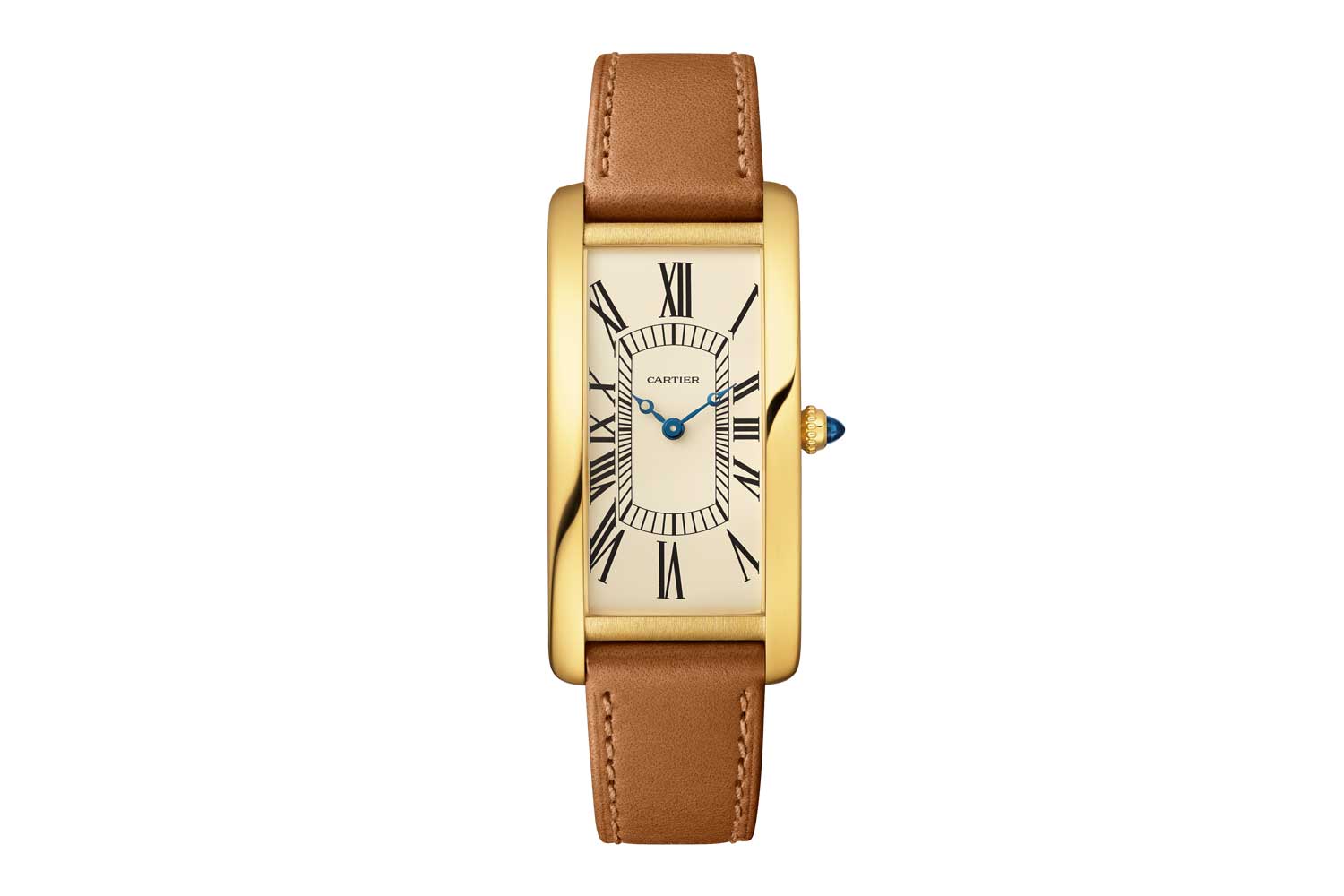
A 150 piece limited edition Tank Cintrée, in yellow gold and in the large size, powered with a hand wound mechanical movement; the watch was launched complete under the radar and directly to customers earlier in January 2021 and is already, completely, sold out
Yellow gold case with ivory dial
Blue Breguet hands
Blue cabochon
46.3mm × 23mm × 6.4mm
Manual winding 9780 MC (based on Jaeger-LeCoultre caliber 849)
Limited to 150 watches
Secondary market value: Higher than retail
Collectability and investment value: Very strong
One of my favorite champagne producers Jacque Selosse was amongst the first to add slight sherry-like flavors to his champagne that evoked the secondary flavors that were produced by aging champagne. Somehow looking at this dial reminds of me of drinking Selosse champagne, in that you have this lovely sense of nostalgia in something that is at the same time modern and high performance.
Of the various Tank Cintrées made over the model’s 100-year history, it is this watch and the 2004 limited edition watch that are the thinnest watches ever created. That’s because instead of the historic caliber 123 that resulted in a watch that was 6.7mm in height, here Cartier is using their caliber 9780 MC, which is actually a reworked ultra thin Jaeger-LeCoultre caliber 849 which dates to the early ’90s. This is the same 1.85mm-thick movement that allowed Jaeger-LeCoultre to produce their 4mm-thick Master Ultra Thin Jubilee watch back in 2013, and the Master Ultra Thin Kingsman Knife watch with a thickness of 4.25mm last year.
The point is, it is only one unique position in alignment with the crown that is truly 6.4mm with the rest of the watch quite a bit thinner. This creates a very unique experience on the wrist where the Tank Cintrée feels incredibly sleek, which together with its signature curved profile, creates what is to my mind one of the most organically unobtrusive watches even when worn with a buttoned dress shirt cuff.
At the same time, looking at the watch, it has a very strong presence on the wrist thanks to its 46.3mm length and 23mm width. So the Tank Cintrée creates this engaging dynamic tension between having a real statement piece on your wrist but one that is incredibly effortless to wear and that fits almost like a bracelet. Amusingly, the only other watch I can think of that has this quality is Richard Mille’s ultra thin RM 67-02, which is from a design perspective almost a polar opposite to the Tank Cintrée.
There was some question about the price increase of this watch relative to the 2018 Tank Cintrée limited edition in yellow gold which was nearly 50 percent less expensive, though I imagine Cartier justifies the difference in price by not only a different movement but also a different case construction. The 2018 watch was significantly thicker at 7.2mm (though it wears much slimmer) versus 6.4mm, featured a snap-on caseback and was also 30 meters water resistant while this watch is not. It seems that the purpose of the 2021 anniversary edition is to follow the construction of the original Tank Cintrée as faithfully as possible and so the caseback is attached in a different way, and as such the watch is not considered water resistant.
From a collectability perspective, that this watch is only the third limited edition Cintrée ever made in significant quantities and the only one to faithfully follow the design of the original Cintrée make it a strong proposition. Expect to see it emerge at auctions posting results well above its USD 29,900 retail price.
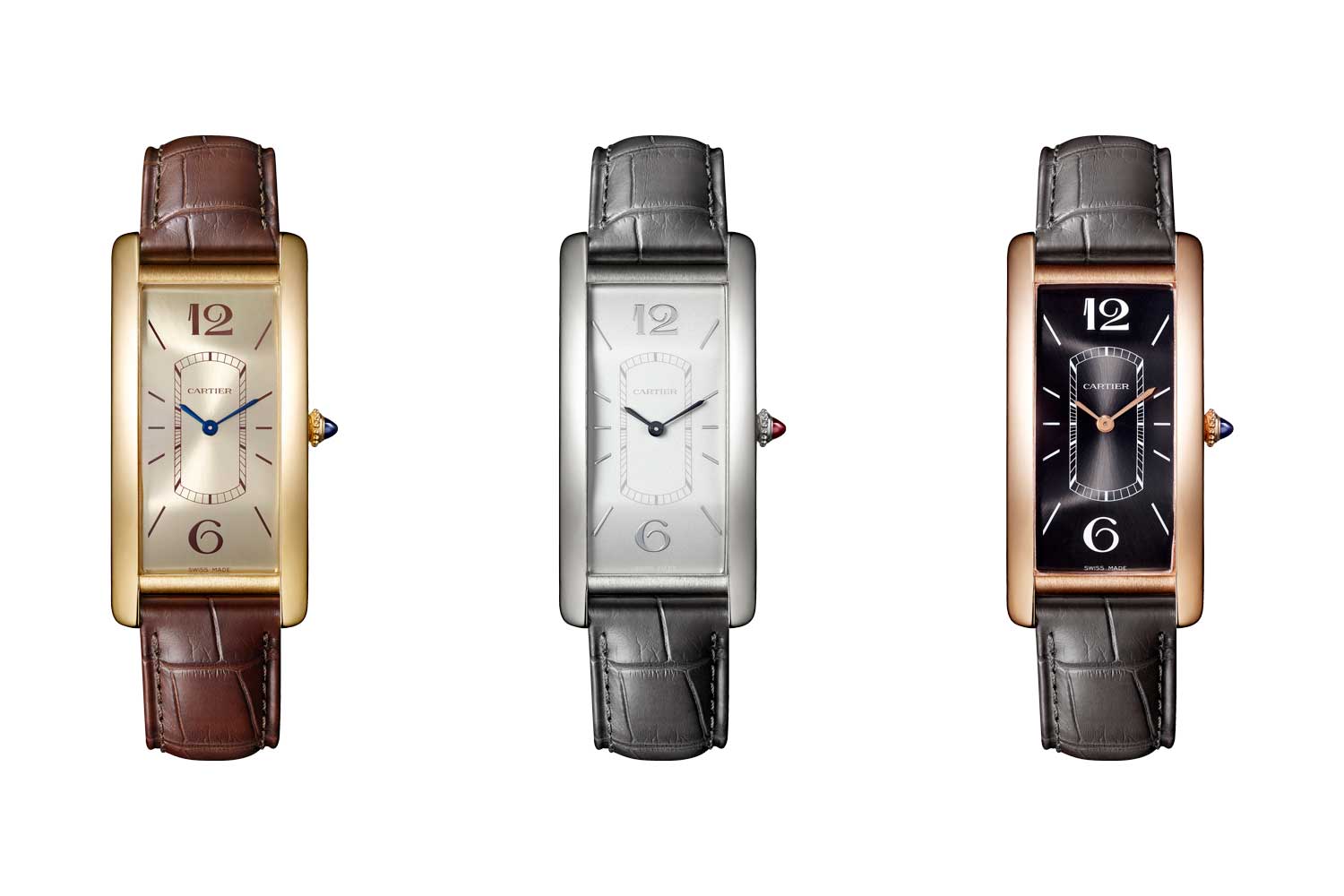
2018 Tank Cintrée with Arabic Numerals “12” & “6” and Baton Markers (©Revolution)
Platinum case with gray dial
Yellow gold case with champagne dial
Rose gold case with black dial
Sword-shaped hands
Blue cabochon for gold models, red cabochon for platinum model
46.3mm × 23mm × 7.2mm
Manual winding caliber 8971 MC (based on Jaeger-LeCoultre caliber 846)
Limited to 100 watches in platinum, limited production of one year for yellow and rose gold models
Retail price: USD 20,400 for yellow and rose gold, USD 23,500 for platinum
Secondary market value: Higher than retail
Collectability and investment value: Very strong
Says Foulkes, “But what Cyrille Vigneron did was even better. He basically transformed the entire brand into CPCP, meaning that every one of the models is an icon.” For many years collectors had been dreaming of a new Tank Cintrée and while a very interesting, skeletonized version had been introduced in 2017, what we wanted was simply the legendary beautifully shaped Tank Cintrée in all its glory. Vigneron gave us exactly that but with a nice twist, which was an all-new dial design. As mentioned, Arabic indexes are rare in Tank Cintrées and the decision to combine them with baton markers is a significant departure from the classic Cintrée dial design. But the overall effect is extremely pleasing.

Cartier CEO Cyrille Vigneron, who in recent years has put the maison's watchmaking on a laser focused trajectory that has yielded some of the most desirable Cartier timepieces in recent memory
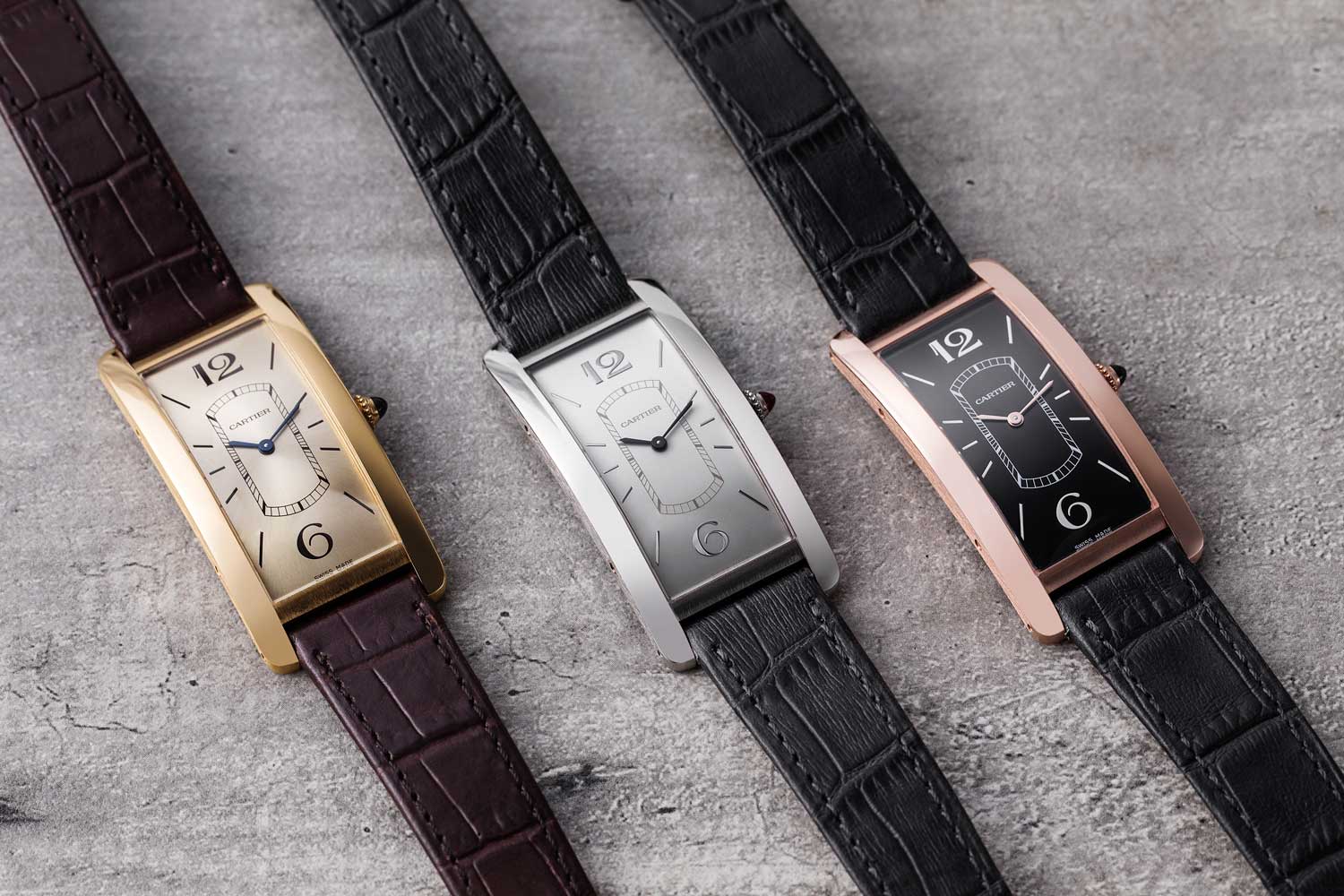
The three executions of the 2018 Tank Cintrée with Arabic Numerals and baton markers (©Revolution)
This allows you the freedom to spontaneously jump into a swimming pool clad in black tie if you’re that kind of person. This case features a snap-on caseback. The other reason the watch is slightly thicker is that instead of using the caliber 9780 MC based on the Jaeger-LeCoultre ultra thin caliber 849, it uses the caliber 8971 based on the Jaeger-LeCoultre 846, which is a movement used in watches such as the Reverso.
One thing that was interesting about the 2018 Tank Cintrée is that it was extremely well priced at USD 20,400 and USD 23,500 for the gold and platinum watches respectively. Perhaps the decisions in terms of slightly thicker case construction had something to do with this, but whatever the reason, it was a very strong value proposition. Finally, as someone that owns a watch with this style case, don’t be misled by the statistic 7.2mm in thickness because, as previously mentioned, this is only at the thickest point of the watch while the rest of the case is considerably thinner. The watch also wears perfectly on the wrist.
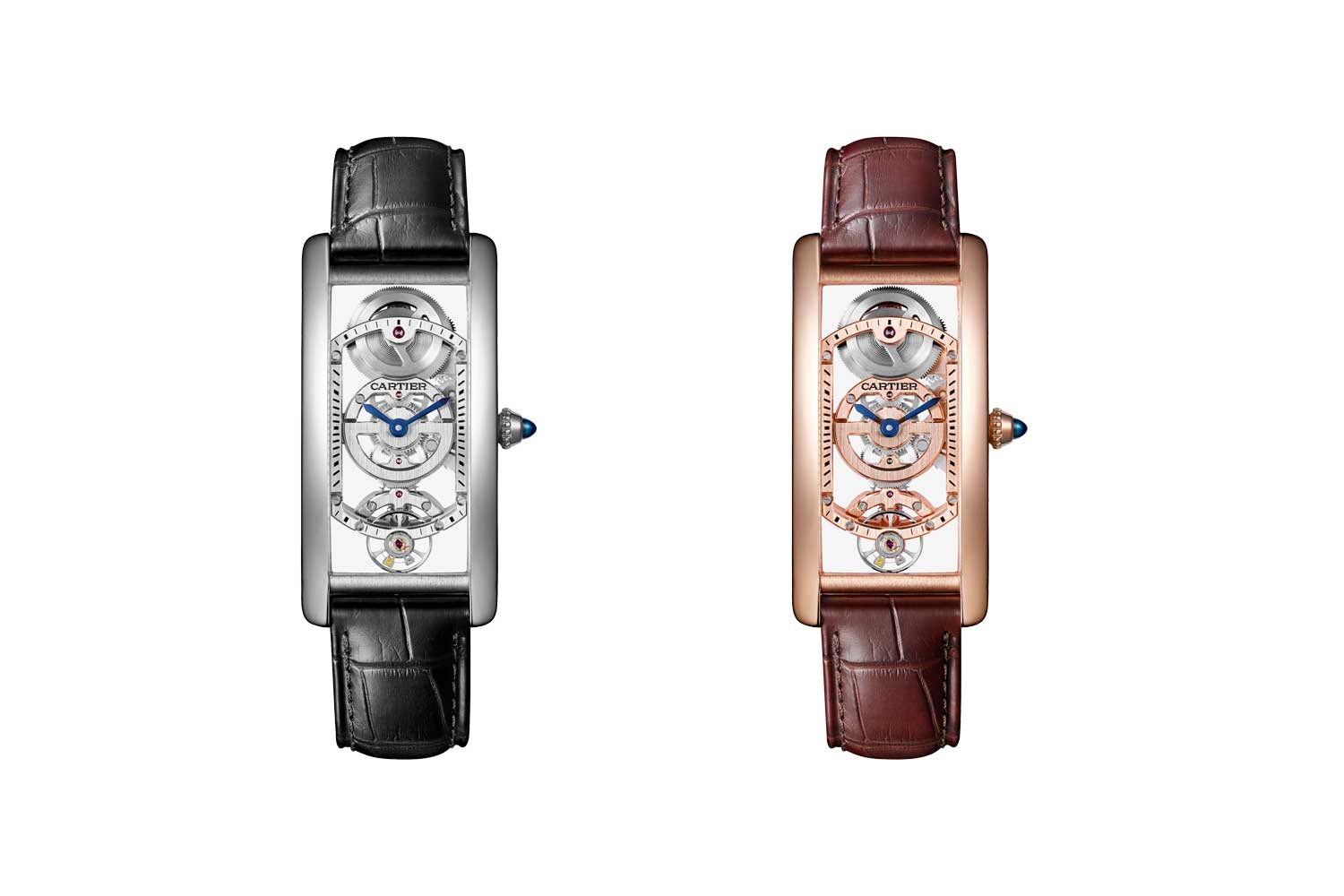
2017 Tank Cintrée Skeleton
Rose gold case and platinum case
Blue sword-shaped hands for both
Blue cabochon for both
46.3mm × 23mm x 7.96mm
Manual winding caliber 9917 MC
Limited to 100 watches each in rose gold and platinum
Retail price: USD 56,000 for rose gold, USD 62,000 for platinum
Secondary market value: Good value
Collectability and investment value: Has potential
In each instance, as is done here, the central aesthetic elements of the dial become the main bridge of the movement, which is absolutely brilliant in terms of a kind of inverse Bauhaus philosophy where function follows form. But this is Cartier at its best; where technical innovation exists to aid in the ultimate goal of beauty and elegance. Here the famous minute track of the Tank Cintrée becomes the primary bridge of the openworked movement and retains both the barrel at 12 o’clock and the balance wheel at six o’clock. The dimensions of the watch are 46.3mm in length by 23mm in width, and 7.96mm in height but, as with all Tank Cintrées, only at the thickest part of the watch. In other words, the watch wears very elegantly on the wrist.
What is particularly great about this timepiece is that while all other Tank Cintrée’s feature flat casebacks, this watch has a curved caseback as the movement is also curved. Because this watch is so radical in departure from a normal Tank Cintrée and because it is also considerably more expensive, at the moment, it has the same cult of collectability around it as the more classic watches. But to me this is definitely a watch to keep your eye on, and perhaps now is a good time to purchase one. The watch was created as part of the celebration of the Tank’s 100th anniversary in 2017, and it was made in 100 examples each in platinum and rose gold.
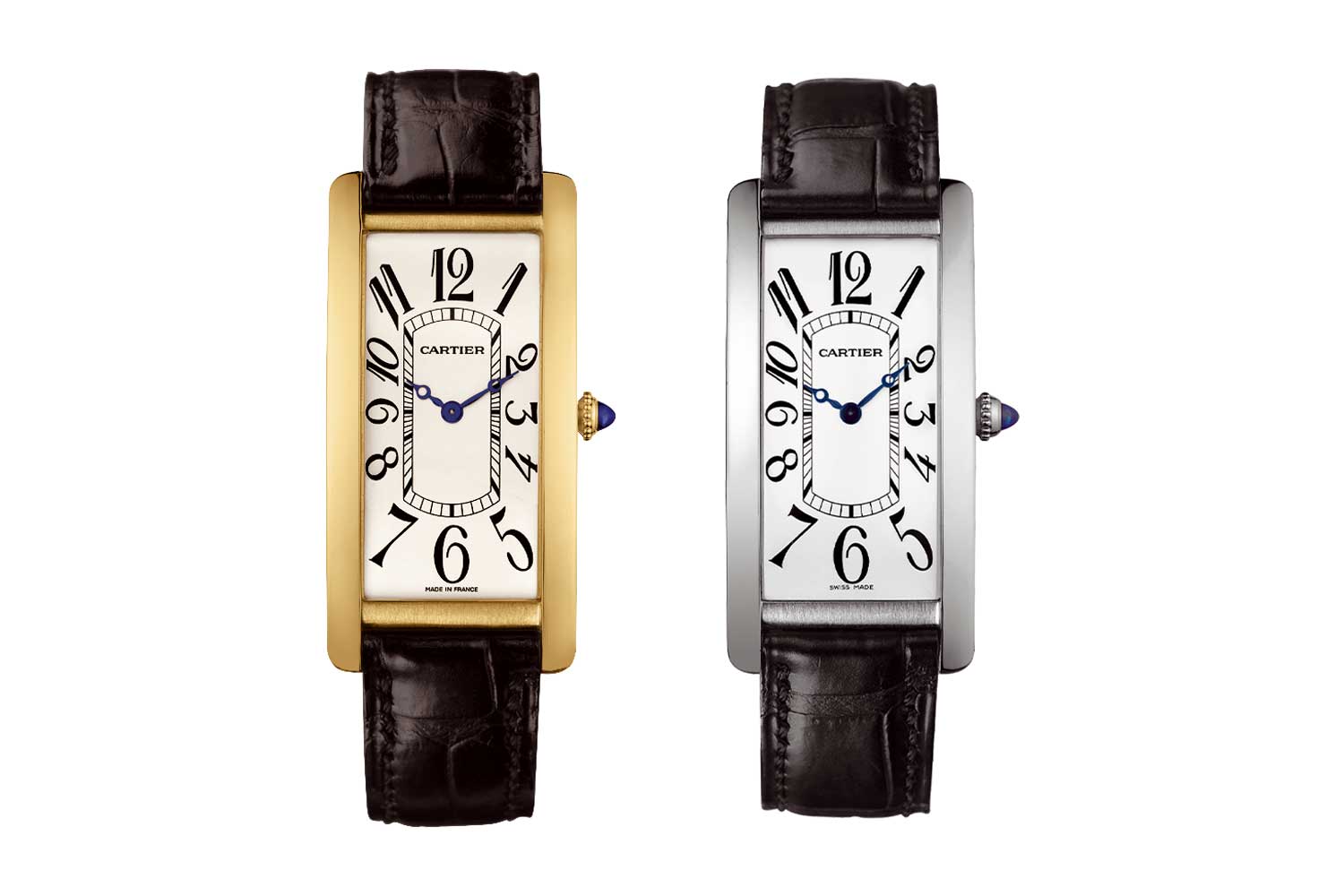
2004 CPCP Tank Cintrée with Arabic Numerals (©Revolution)
Platinum case with silver dial
Yellow gold case with white dial
Blue Breguet hands
Blue cabochon for yellow gold case, black cabochon for platinum case
46.3mm × 23mm × 6.4mm
Manual winding caliber 9780 MC
Limited to 50 watches in platinum, 150 watches in yellow gold
Retail price: No longer available
Secondary market value: Higher than retail
Collectability and investment value: Grail
Several reasons: First, it has to do with the overall success of Cartier which is now exhibiting major critical momentum in perceived value and collectability, thanks to its CEO Cyrille Vigneron. Second, there is a very strong interest in Tank Cintrée watches; I would say that next to the Crash, it is the second most sought after Cartier watch across all categories new, pre-owned and vintage. Third, this particular execution is the only time the Tank Cintrée has been made in series with an Arabic index dial, making it very significant in terms of Cartier’s history. There have been are special order instances with Arabic numerals from across the 20th century, but nothing that was produced in series. Fourth, it is a CPCP watch and the world now realizes how amazing CPCP is.
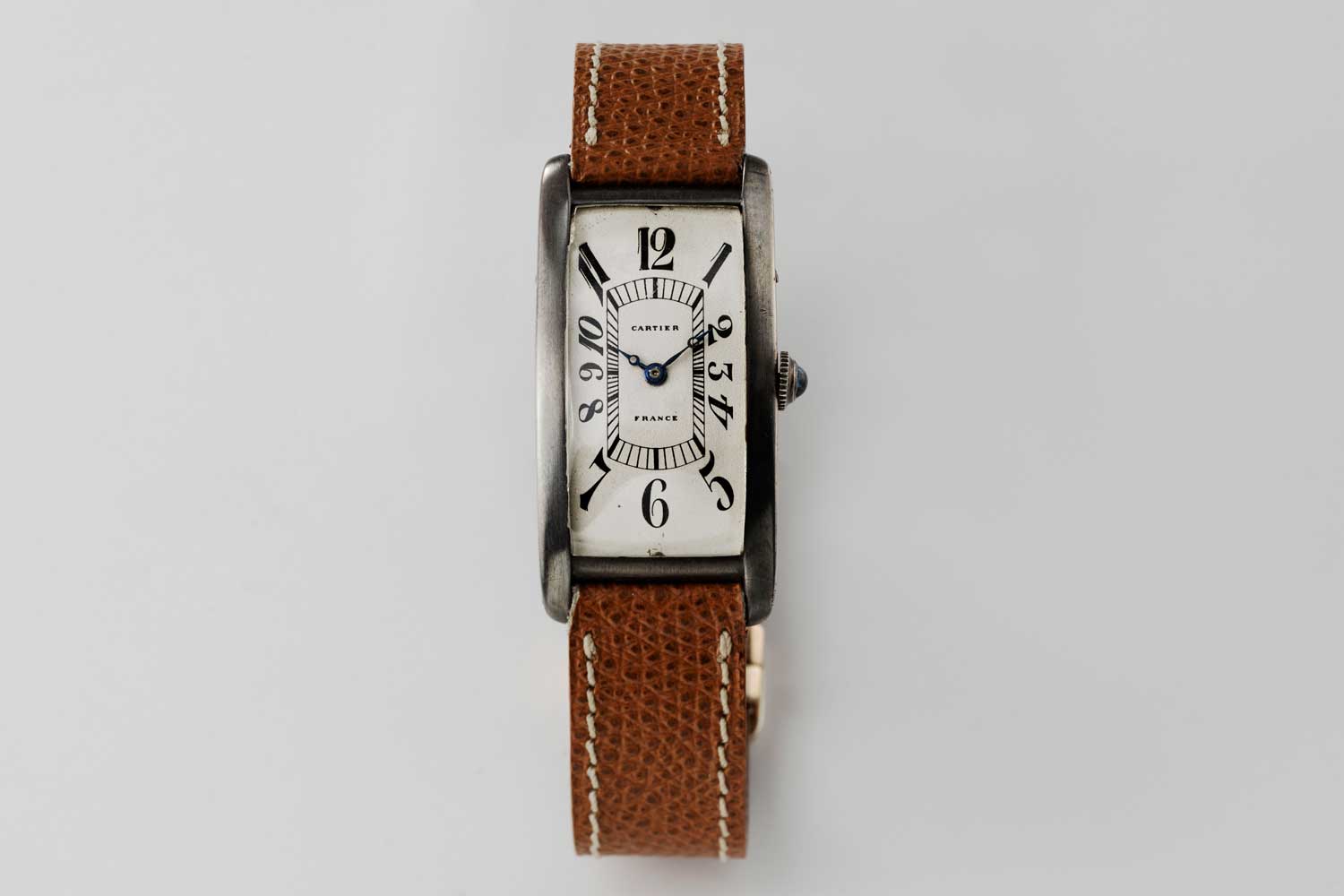
1926 made in France Cartier Tank Cintrée, possibly pièce unique with a silver case and elongated Arabic numerals; powered by a European Watch movement; this particular piece is from the private collection of Auro Montanari (©Revolution)
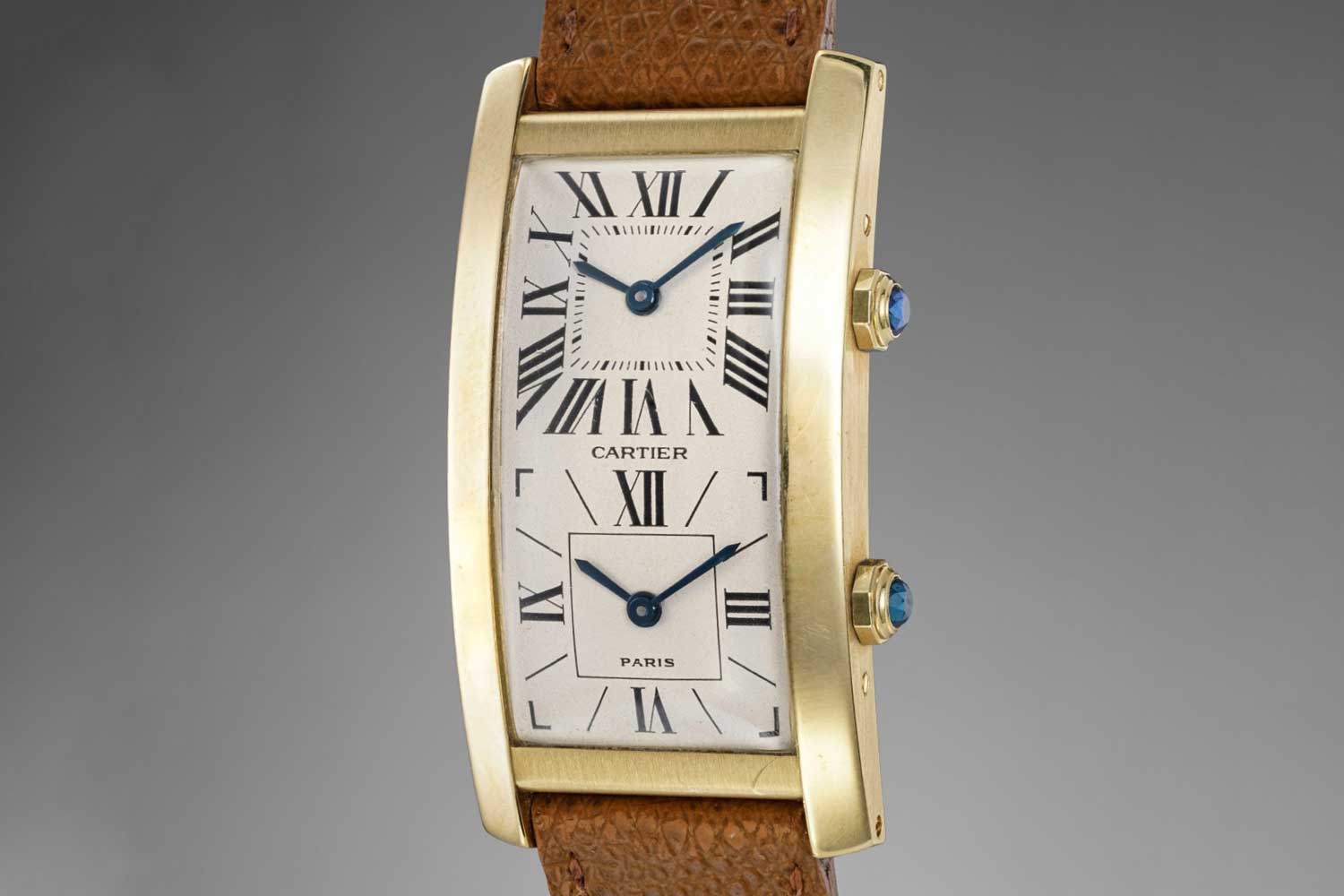
1990 Cartier Tank Cintrée Dual Time in yellow gold; sold with Phillips in 2018 for CHF 8,750 (Image: phillips.com)
Platinum case with white dial
Yellow gold case with white dial
Blue sword-shaped hands for both
Blue cabochon for both
46.3mm × 23mm
Manual winding ETA caliber 2412
OK, so the 1990 Tank Cintrée Dual Time is something of an oddball in that it is actually two watches in one case. Or, more specifically, to create this design, Cartier fit two complete movements (based on the ETA 2412 caliber) into the space of the 46.3mm × 23mm Tank Cintrée case. Which means each of the displays can be individually adjusted and set to any time. Should you wish to purchase the Tank Cintrée Dual Time, you also have to live with the idiosyncrasy of having to manually wind both of these tiny movements pretty much daily. But all of this is precisely the reason I absolutely adore this watch.
To me, it is Cartier design ingenuity at its best with a wonderfully poetic approach to the pragmatic act of creating a multi time zone watch. Note that it actually is one of the few watches that can reflect time zones with half hour deviations as you find, for example, in India. Of the various complications, this is one of the most fun and inventive. Note that instead of the normal beaded crown with elongated cabochon, here the Dual Time uses two faceted octagonal crowns (like those in the Tank Américaine) with flatter cabochons, presumably to make winding and setting the time a great deal easier.
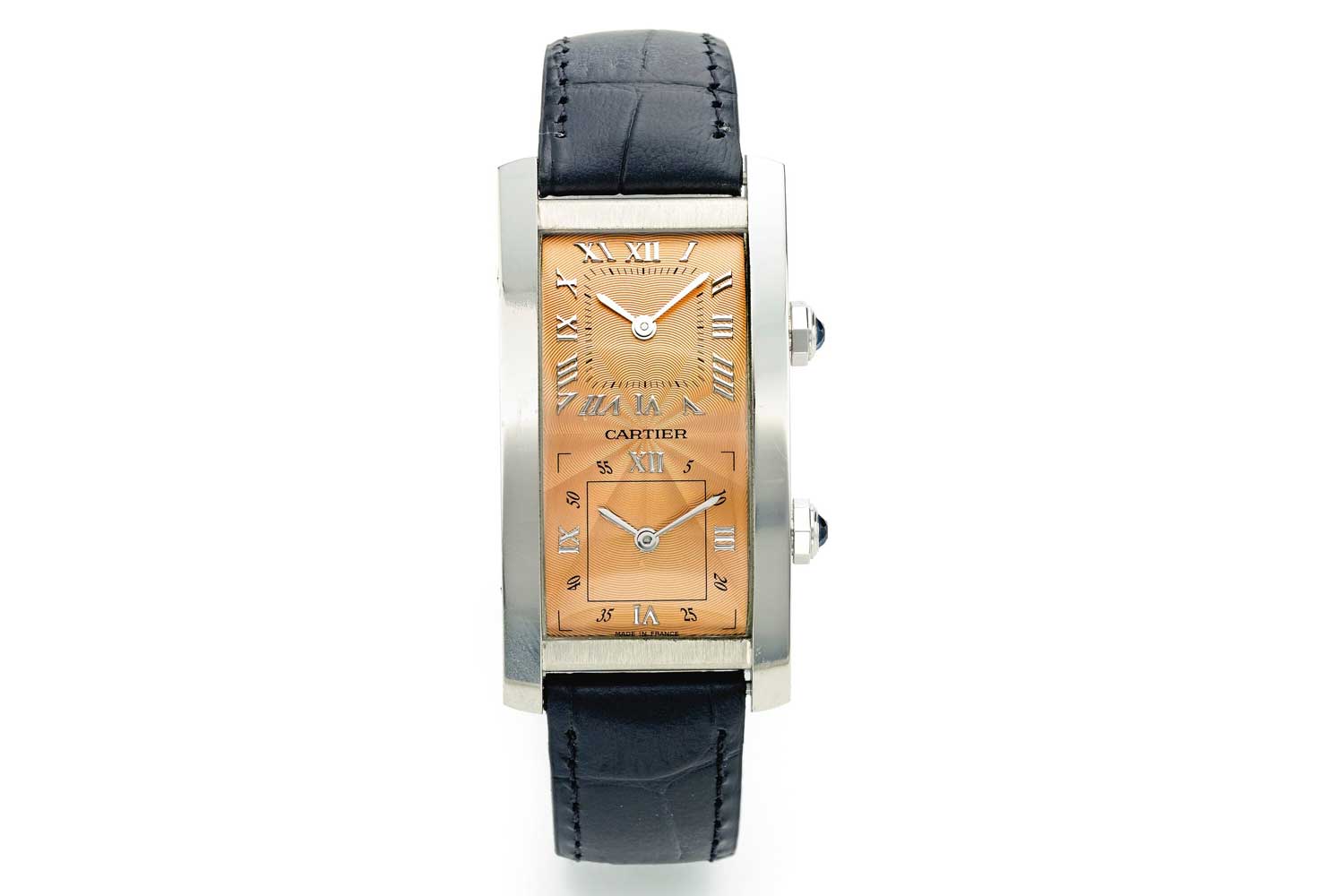
50-piece limited edition dual time Cartier CPCP Tank Cintrée in platinum, circa 1998, sold by Sotheby’s in 2015 for USD 9,375 (Images: sothebys.com)
Interestingly, instead of the guilloché emanating from the center of each of the two dials as Cartier would do on the CPCP Tonneau Dual Time with this same complication, here the guilloché emanates from the center of the dial and then flows across both the time displays.
There was also a version with Roman numerals on the upper dial and Chinese characters on the lower dial that was made in a series of 100 watches for the Asian market.
All of these watches resonate strongly with me and I would love to see a collector make an effort to unite all versions of this complication, including the Tonneau watches, in one collection.
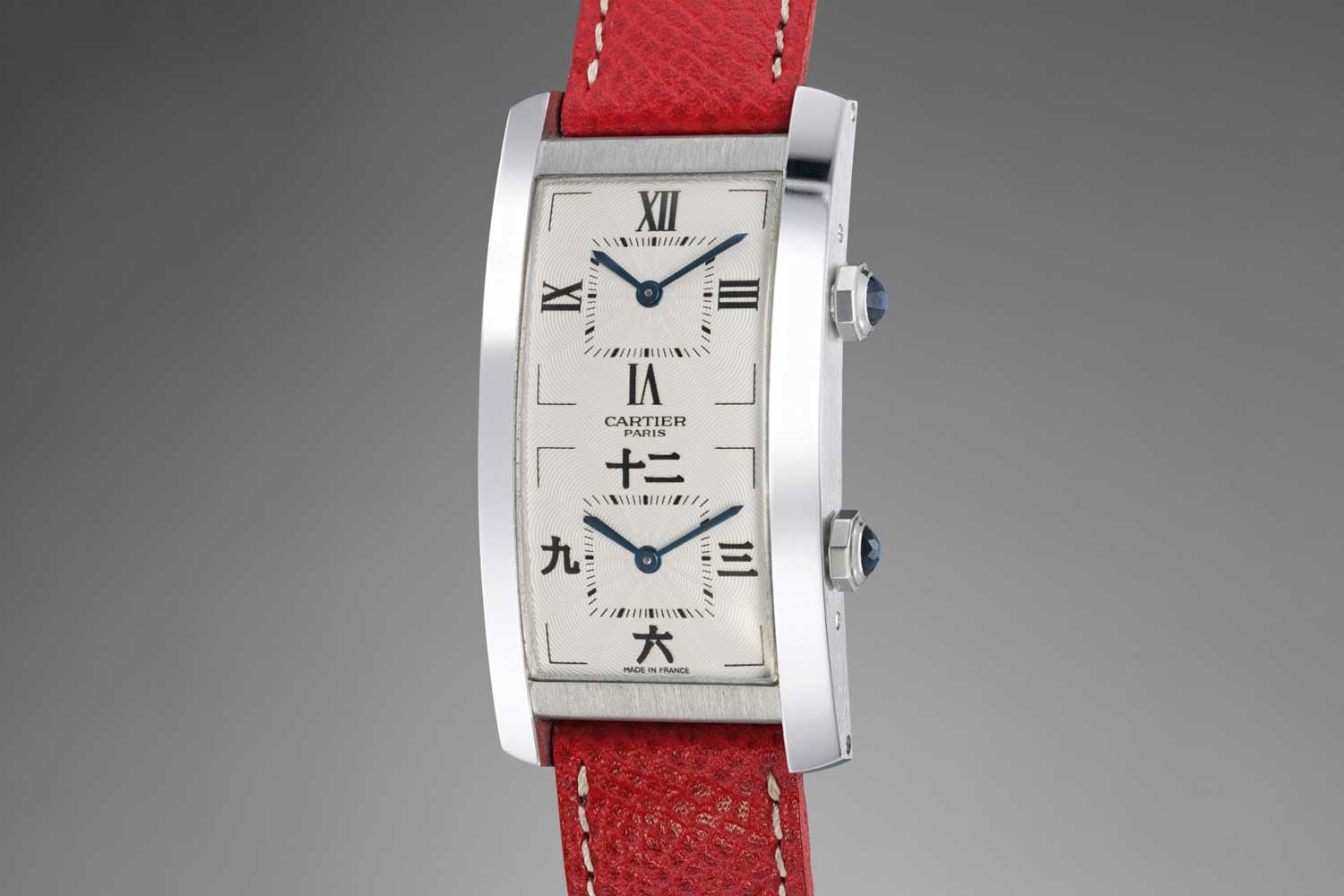
2004 Cartier Tank Cintrée Dual Time in 18K white gold; limited edition of 100 pieces powered by the manual, cal. 060MC; sold by Phillips in 2018 for CHF 32,500 (Images: phillips.com)
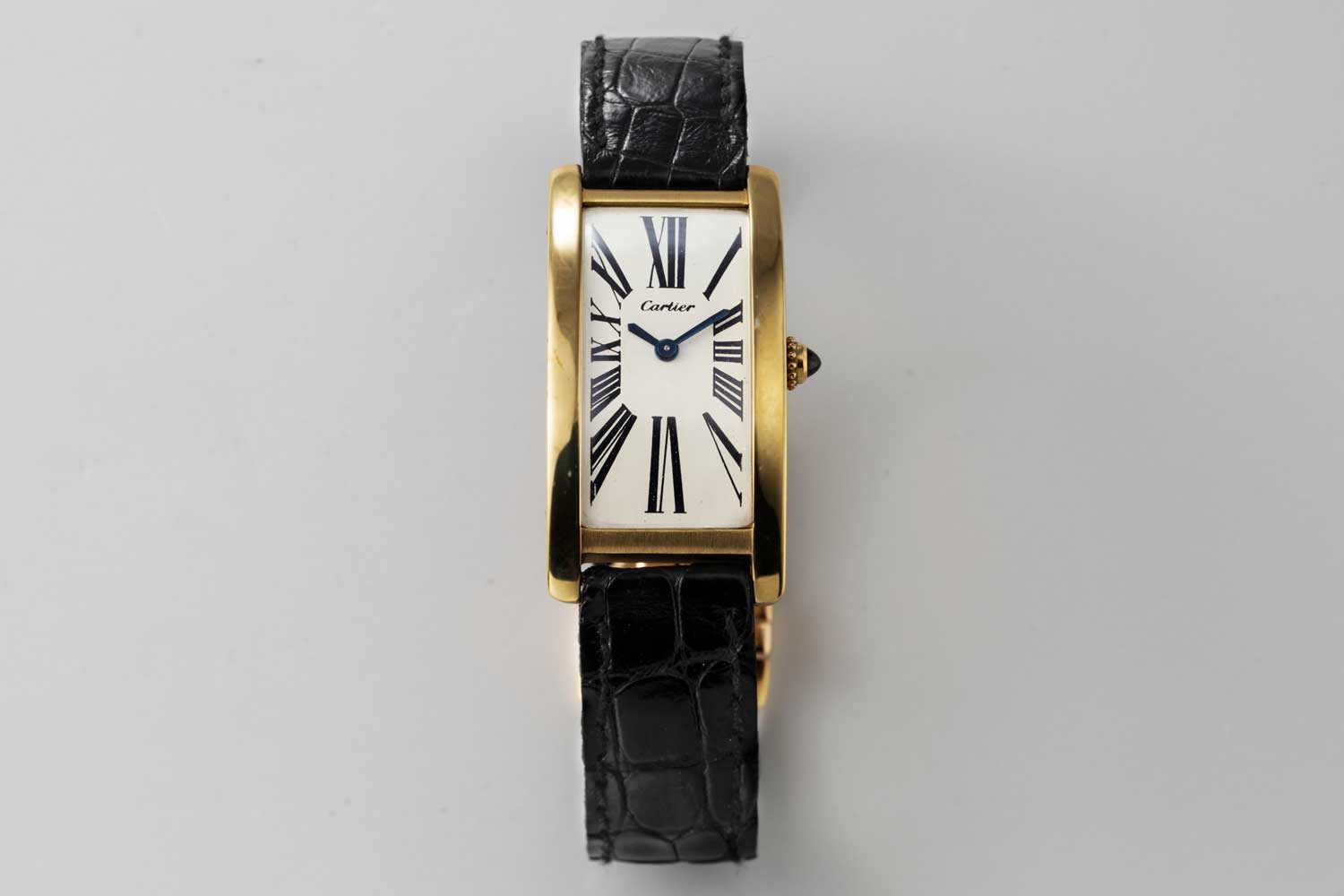
A 9-lignes, 1969 London Cartier Tank Cintrée; dial of the watch has a design which features serif Roman numerals that almost seem to explode from the center of the dial and reach for the edge of the case with a thrilling vibrancy; this particular example is from the private collection of Auro Montanari (©Revolution)
There we see the design which features serif Roman numerals that almost seem to explode from the center of the dial and reach for the edge of the case with a thrilling vibrancy. The feet of these indexes form a rectangle in the center of the dial that offers a sanctuary of calm relative to the thrilling dynamism of the indexes. This dial is used across the different sizes of the Tank Cintrée made by Cartier London but works best in the largest size with a 9-ligne movement, as you will see in the image on page 111 of the book.
Here you will find a Cartier London advertisement showing the various watches on offer and amongst them is a smaller size Cintrée, most likely a 7-ligne movement watch, which demonstrates that this dial design is less dynamic when there is less space for the Roman numerals to stretch through space. It is nonetheless a beautiful watch.
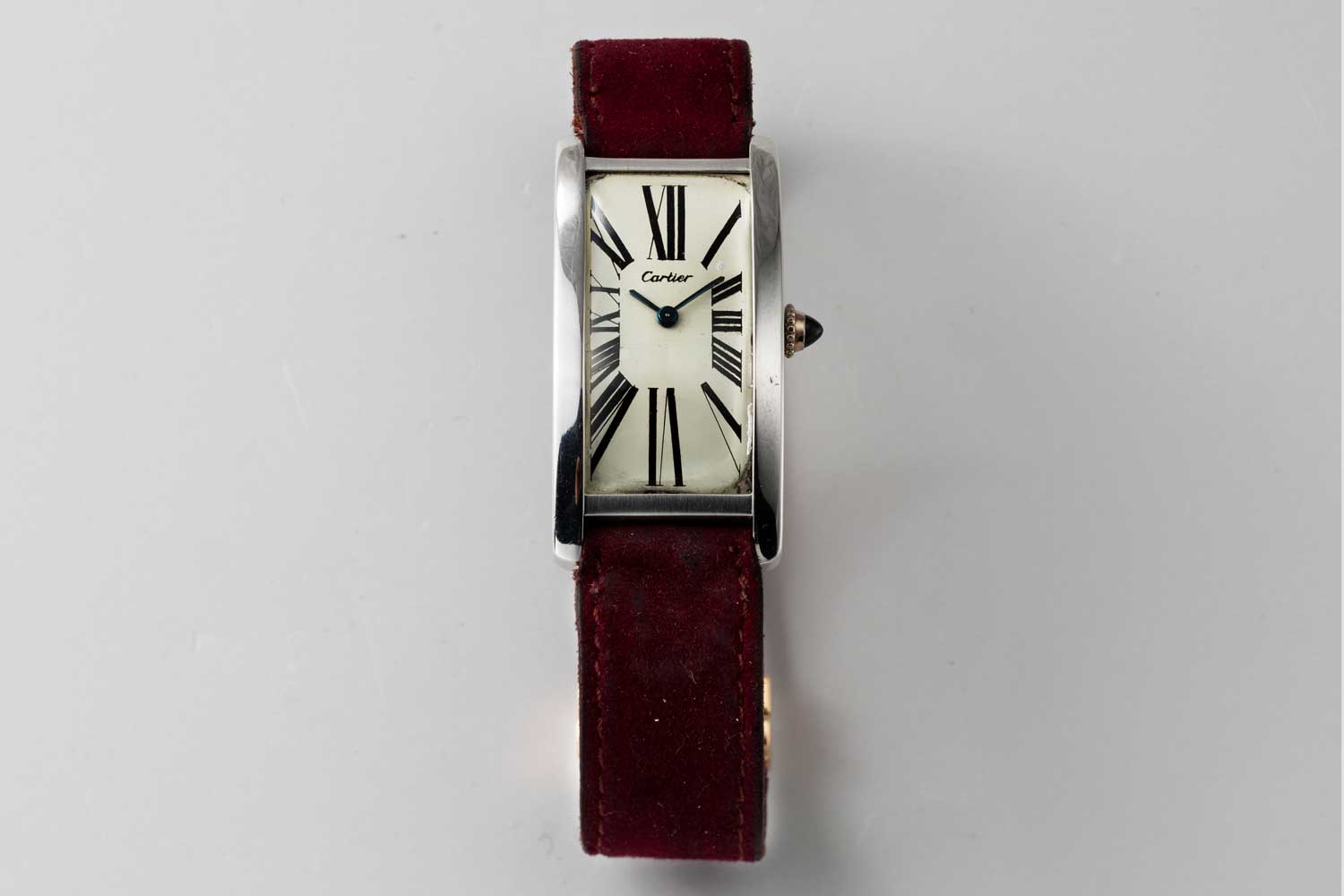
A 9-lignes, 1970 London Cartier Tank Cintrée in the rarer white gold case; this particular example is from the private collection of Auro Montanari (©Revolution)
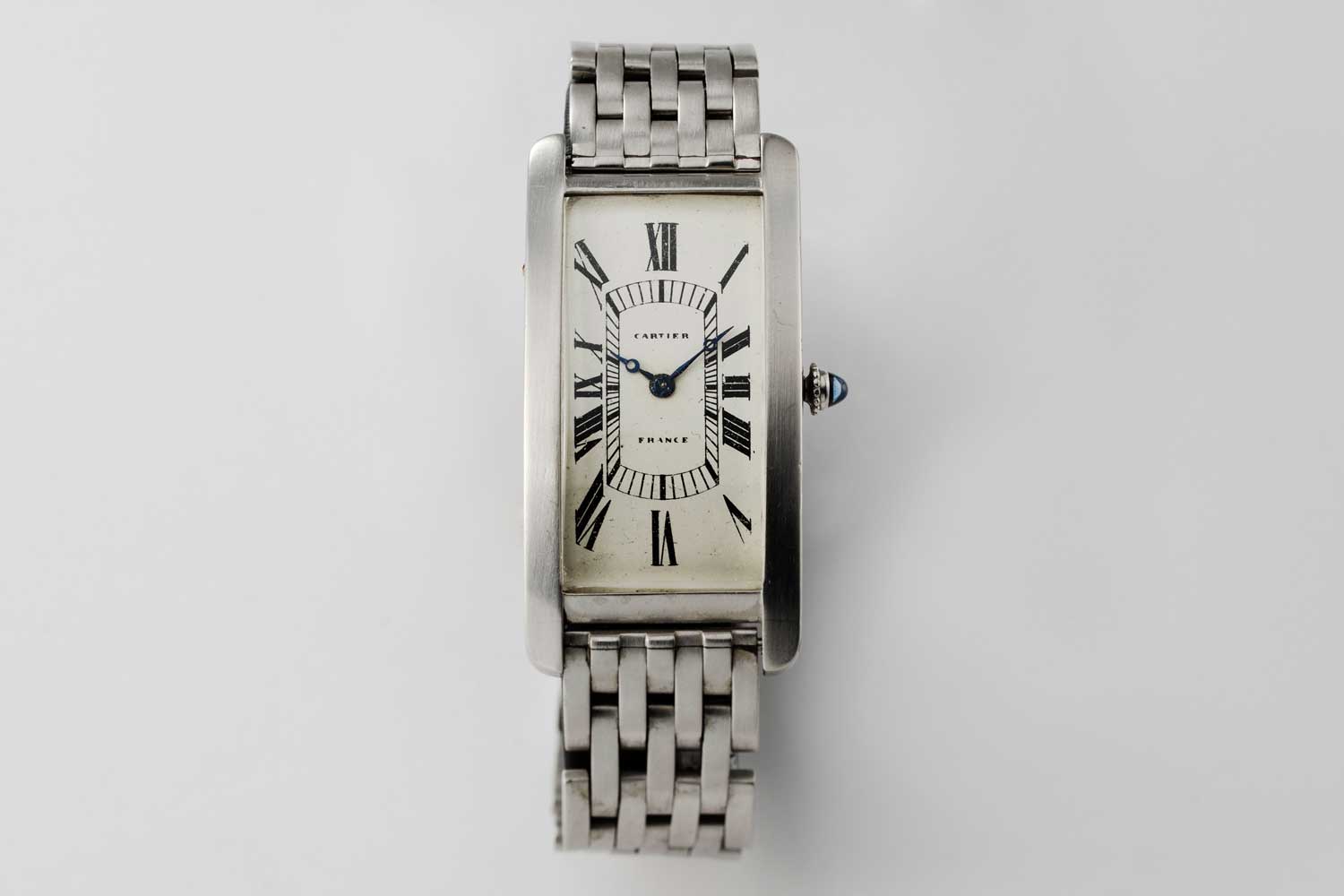
1928 Platinum Cartier Tank Cintrée with original 7-link platinum bracelet; this particular example is from the private collection of Auro Montanari (©Revolution)
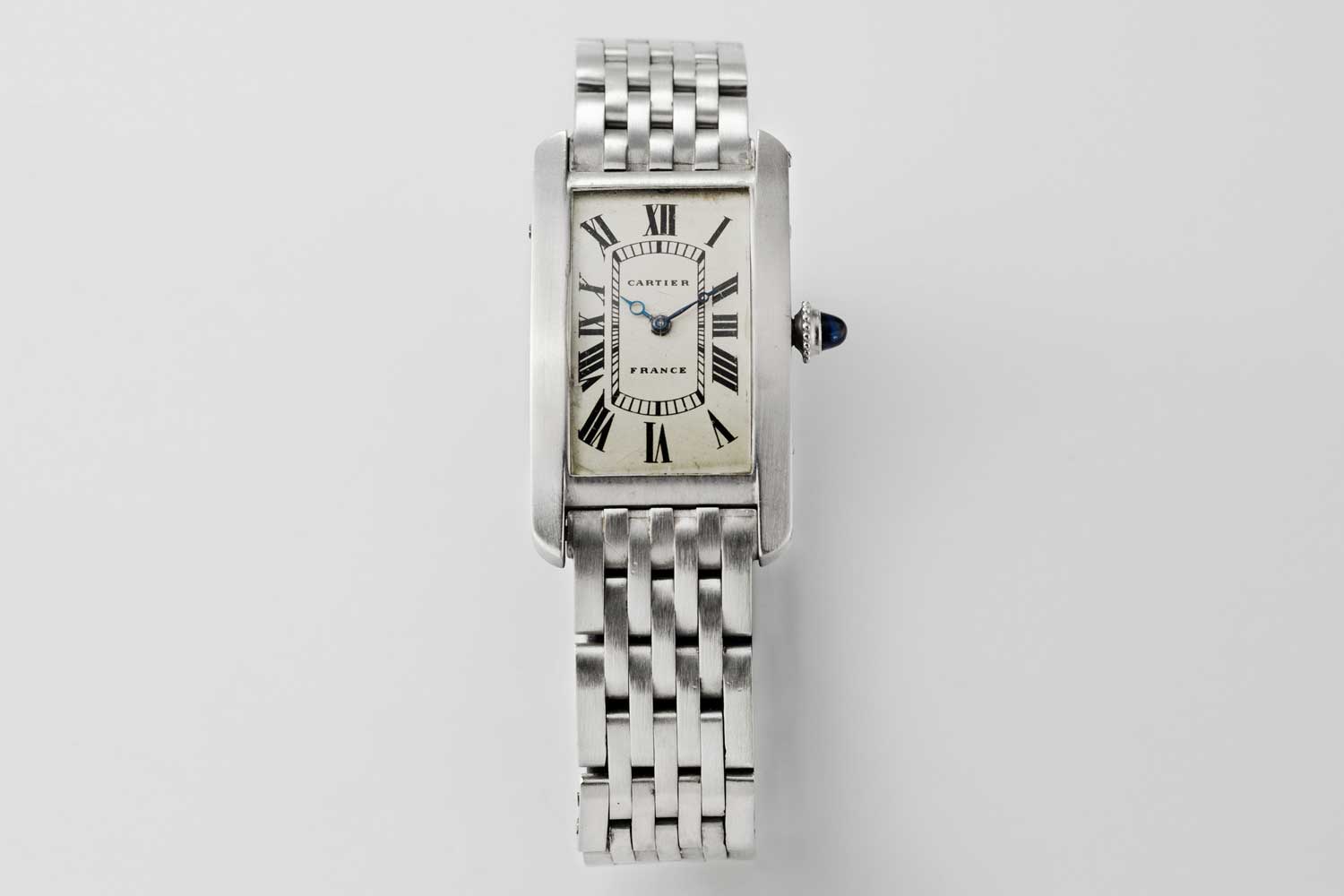
1930 Cartier Platinum Tank Cintrée made in France, medium size with original pt. 7-link bracelet; this particular example is from the private collection of Auro Montanari (©Revolution)
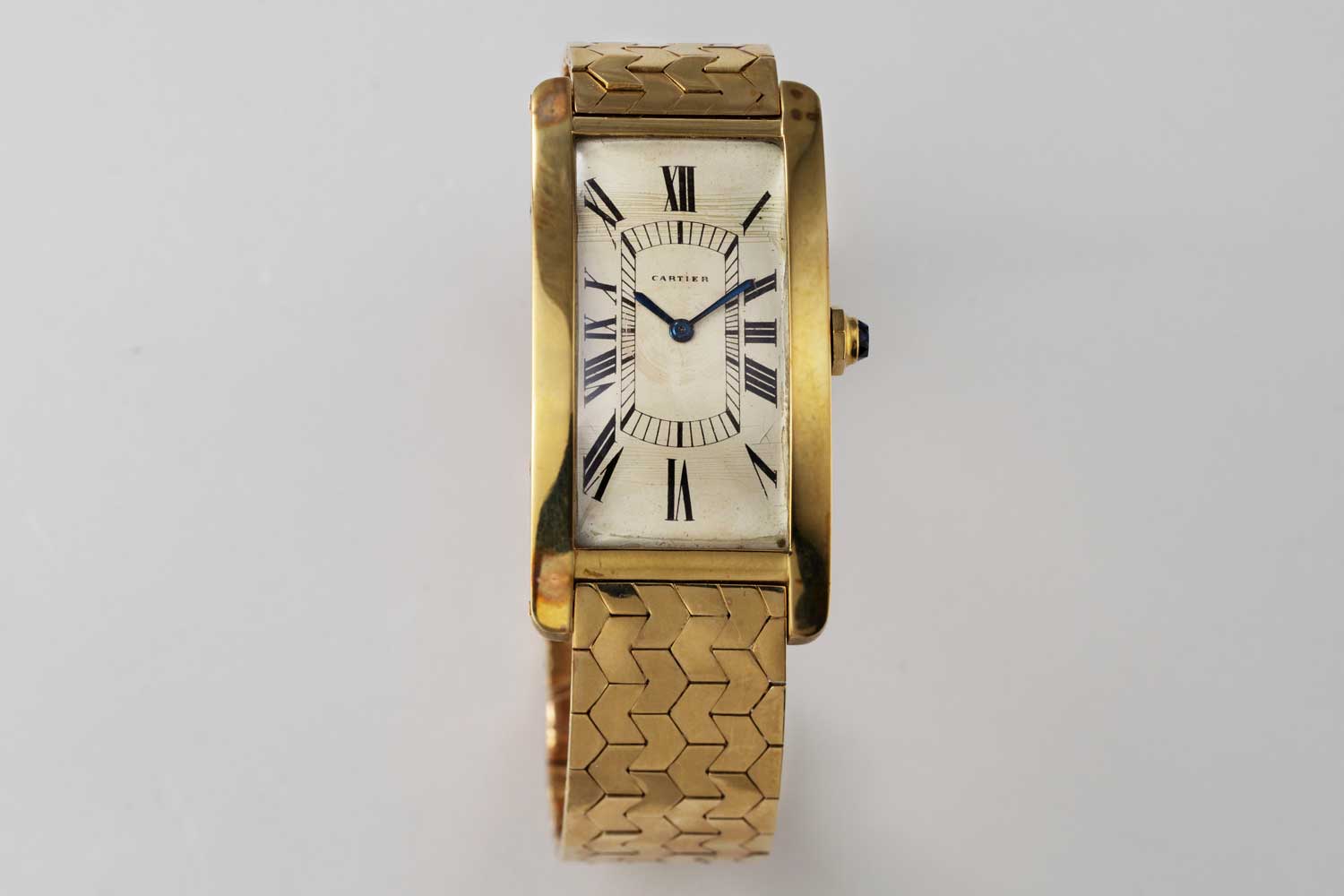
1951 yellow gold Cartier Tank Cintrée with original yellow gold bracelet; this particular example is from the private collection of Auro Montanari (©Revolution)
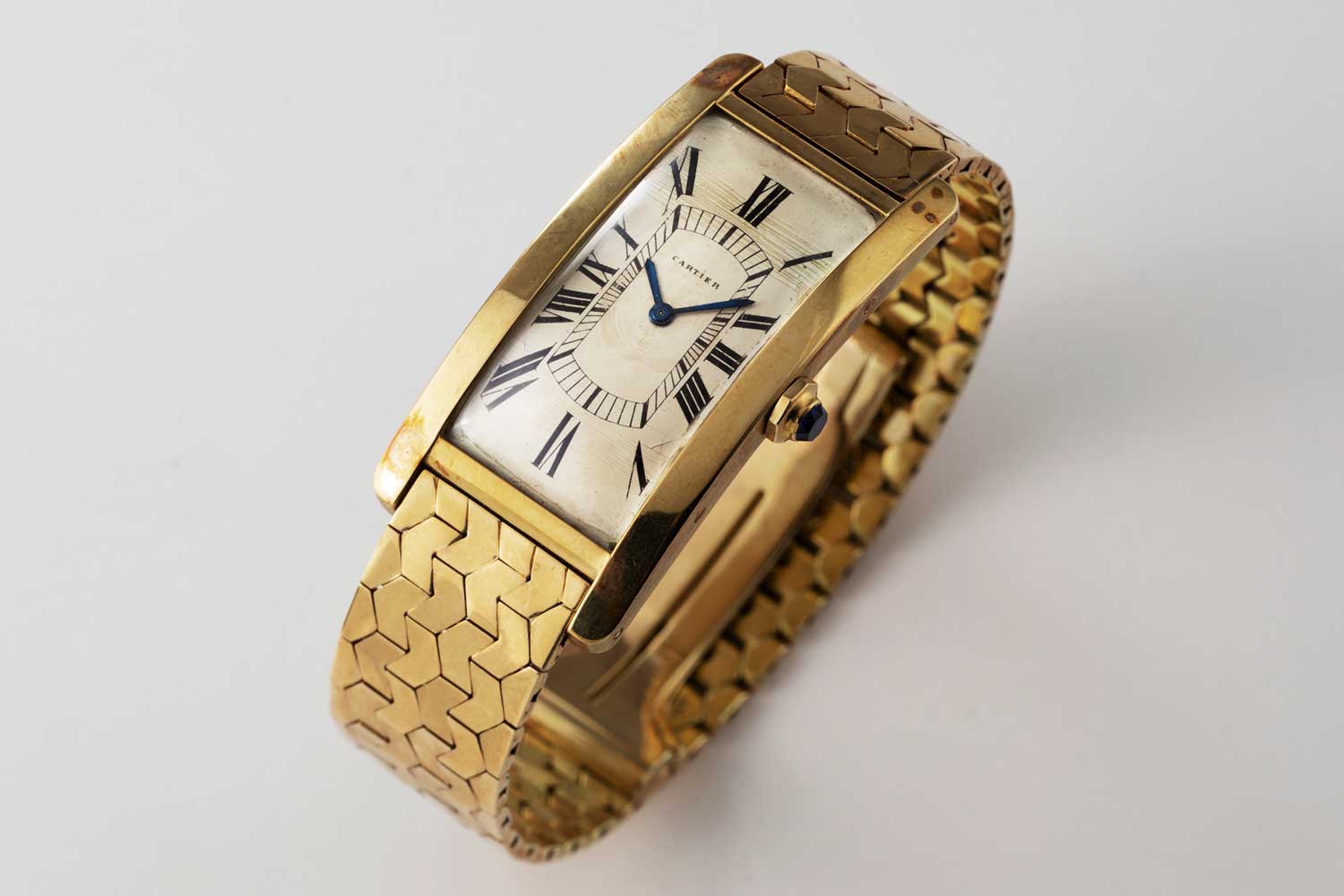
1951 yellow gold Cartier Tank Cintrée with original yellow gold bracelet; this particular example is from the private collection of Auro Montanari (©Revolution)
If it was indeed popular with the Rakes of the Riviera such as Rubirosa, Agnelli and even Prince Rainier of Monaco, it is clear then that the Tank Cintrée was a mark of taste amongst the world’s most elite playboys. Bear in mind that the watch was made in each of the independent outposts of Cartier in Paris, London and New York. Auro Montanari states, “The construction of these watches varies from era to era but follows the general iconography. What is also very beautiful are watches that featured matching metal bracelets.”
This is perhaps the ultimate Tank Cintrée — a gold or platinum watch with a matching bracelet. Says Montanari, who owns a staggering number of these, “Let’s not forget that Cartier was a jeweler and for them the creation of wonderful and inventive bracelets was second nature. The most common of these would be the seven-link and Milanese mesh bracelets, but there are also woven herringbone bracelets. While I have stated my preference for the largest case size of the Tank Cintrée I should also say that the watches with the 8- and 9-ligne movements look wonderful with these types of bracelets.” Watches continued to be made all the way into the ’90s before the advent of CPCP.
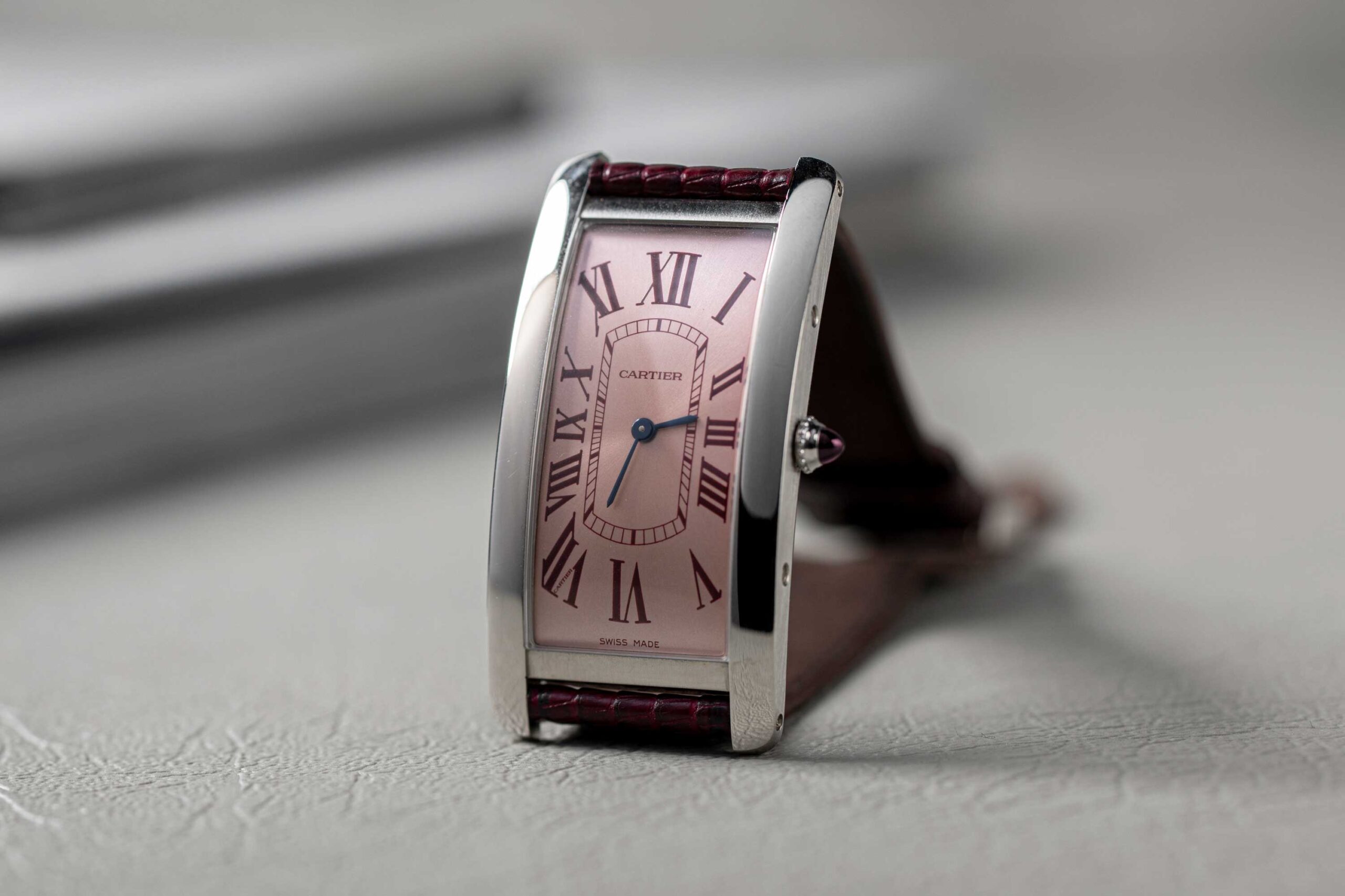
Wei Koh’s special order Cartier Tank Cintrée in platinum with a salmon dial and burgundy Roman numerals, fitted on a burgundy lizard strap made by Federico De Peppo of Huitcinq1988 (©Revolution)
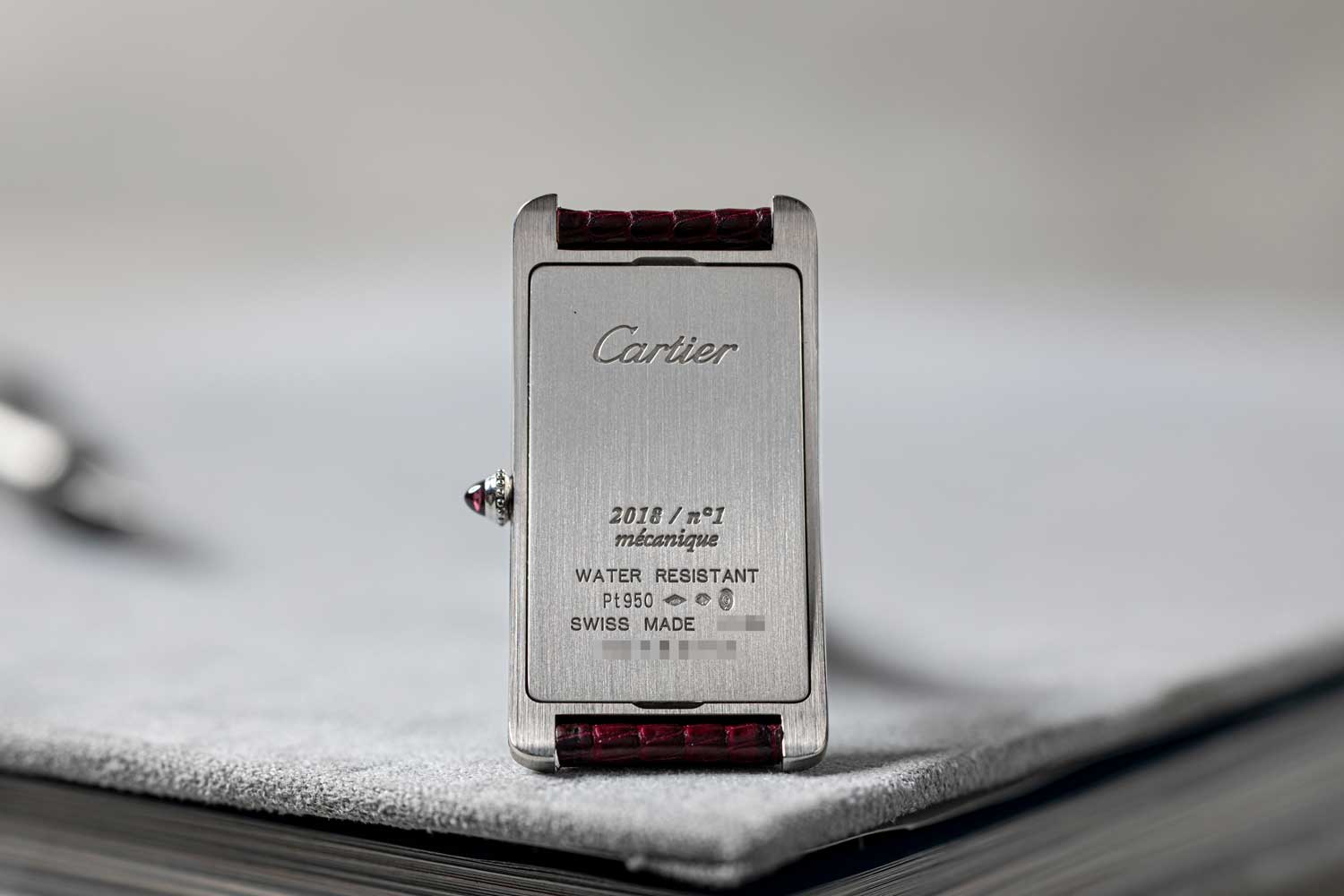
Wei Koh’s special order Cartier Tank Cintrée in platinum with a salmon dial and burgundy Roman numerals, fitted on a burgundy lizard strap made by Federico De Peppo of Huitcinq1988 (©Revolution)
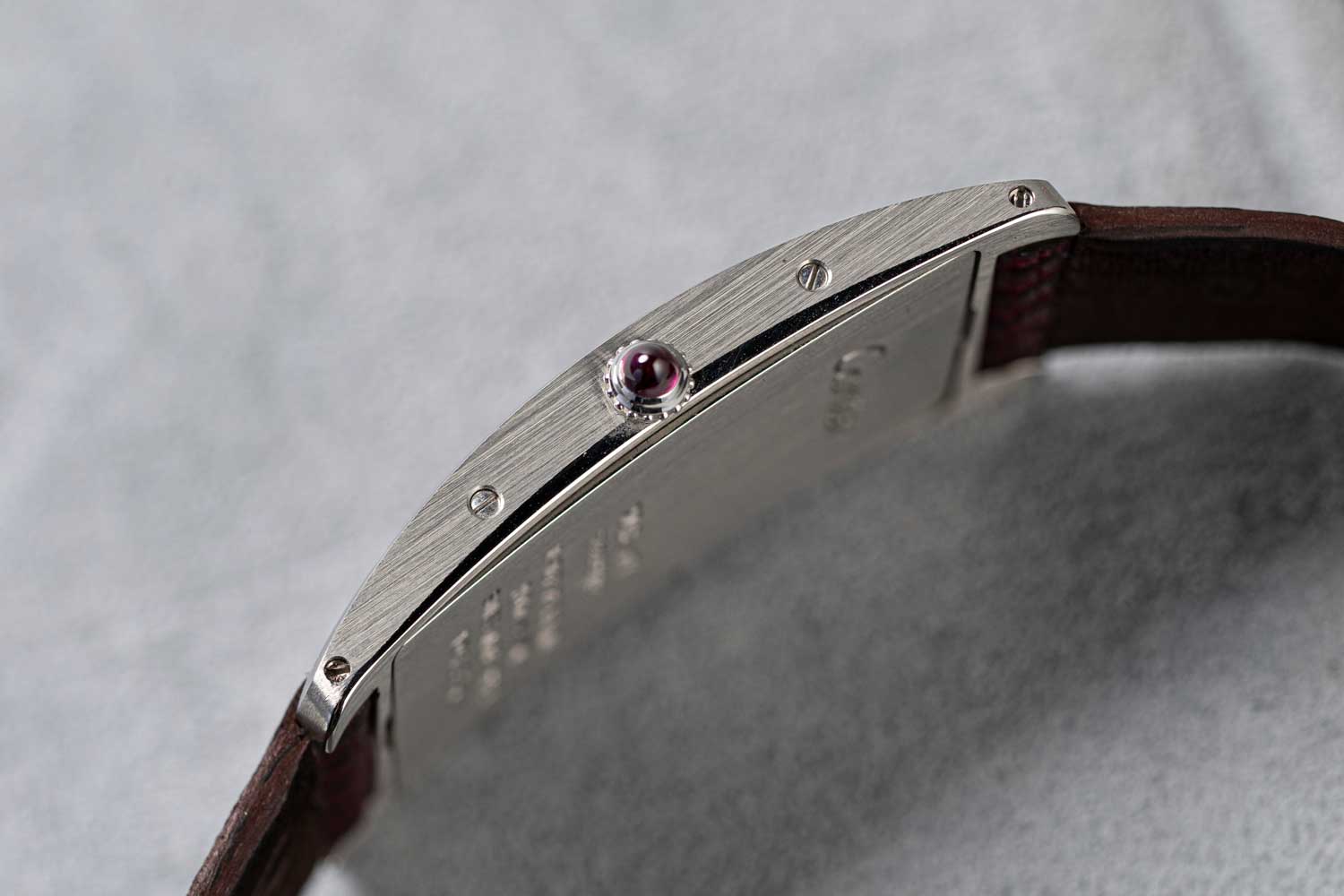
Wei Koh’s special order Cartier Tank Cintrée in platinum with a salmon dial and burgundy Roman numerals, fitted on a burgundy lizard strap made by Federico De Peppo of Huitcinq1988 (©Revolution)
Cartier has always had a powerful direct relationship with its clients. And one amazing dimension to the brand is the exclusive special orders department where you can request for a special dial or even a special case. Of course, your design needs to be approved by Cartier’s heritage director, the amazing fount of knowledge that is Pierre Rainero.
I am often asked how one becomes a Cartier special order customer and my response to that is there really is no short-cut. You need to develop your relationship with Cartier. The other suggestion I would make is this, “Just be nice.” The people at Cartier, at least the ones I’ve met in Singapore and in Paris, are very warm, genuine and smart people. I would definitely describe Cartier’s regional managing director Cecile Naour, Singapore managing director Anne Yitzhakov, Singapore marketing and communication director Imane Laasr and its commercial director Gregory Hallak in this way. They are great people who love what they do and are very good at it. Again, I think this is also very much part of Cyrille Vigneron’s leadership, where there is now a strong prevailing intelligence about their own brand that permeates Cartier culture.
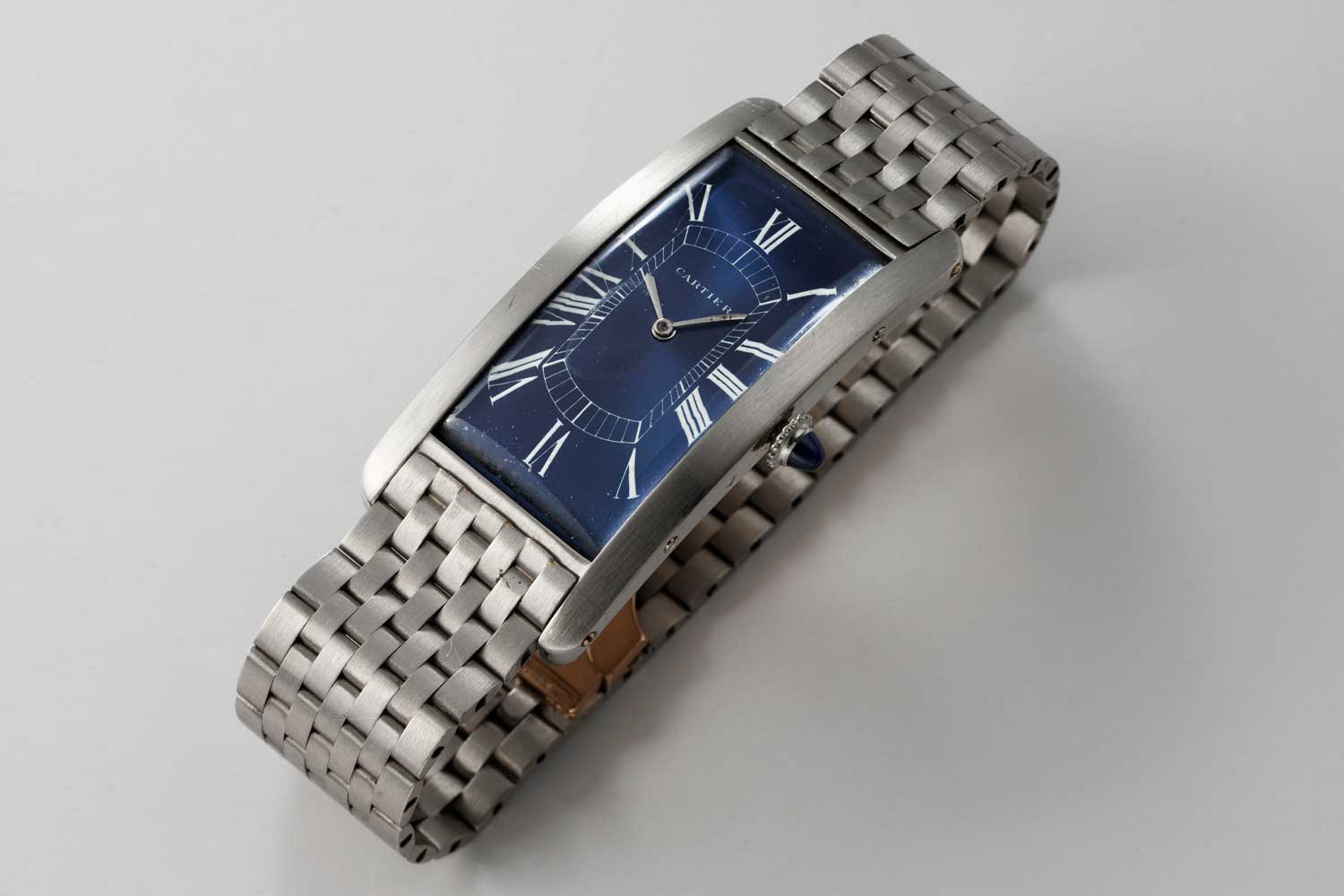
1929 platinum Cartier Paris Tank Cintrée with European Watch movement; In the middle of the 1990s a special order was made with Paris for a new blue dial with white Roman numerals, ie the dial placed in the case at the moment is not the same one from 1929; this particular example is from the private collection of Auro Montanari (©Revolution)
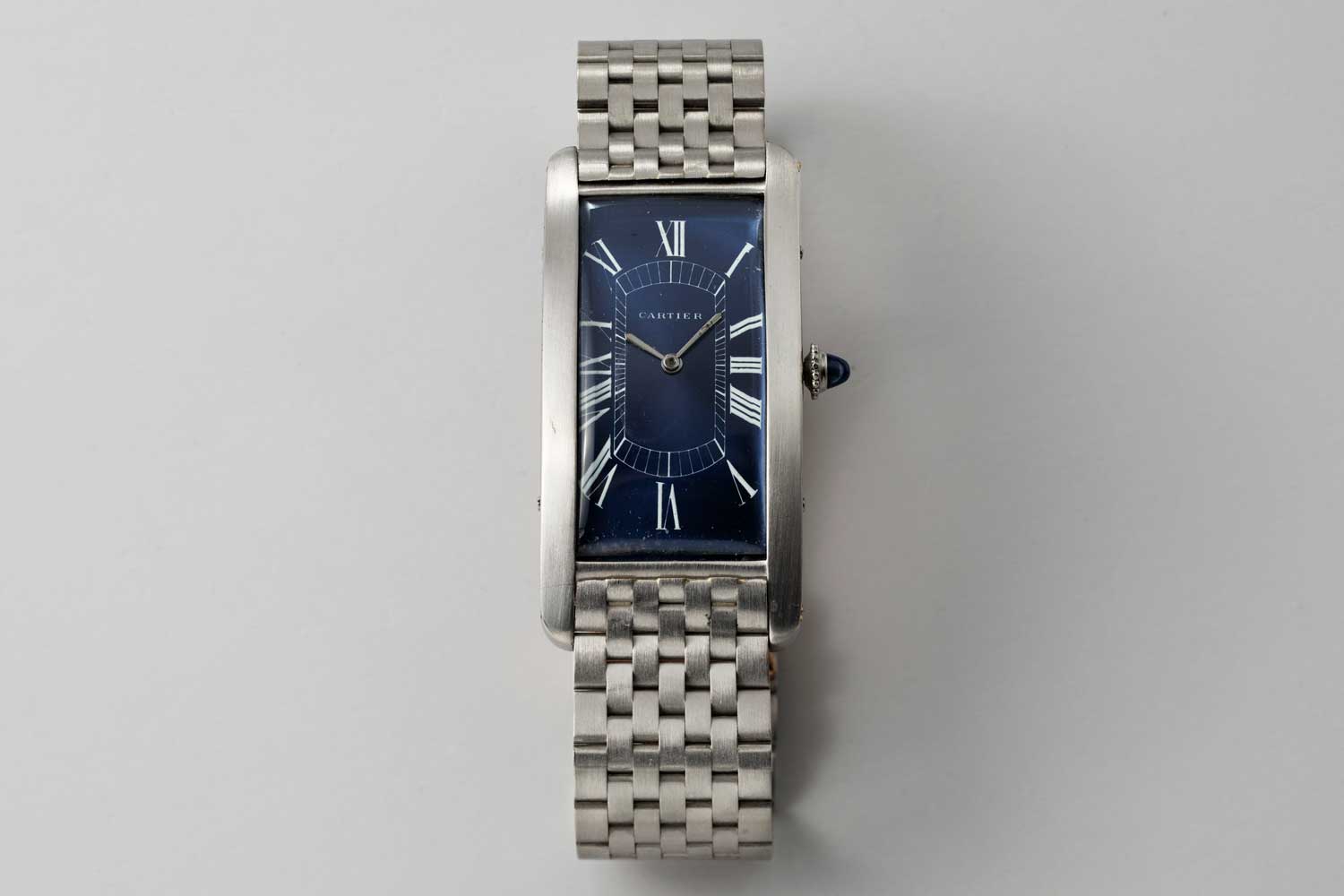
1929 platinum Cartier Paris Tank Cintrée with European Watch movement; In the middle of the 1990s a special order was made with Paris for a new blue dial with white Roman numerals, ie the dial placed in the case at the moment is not the same one from 1929; this particular example is from the private collection of Auro Montanari (©Revolution)
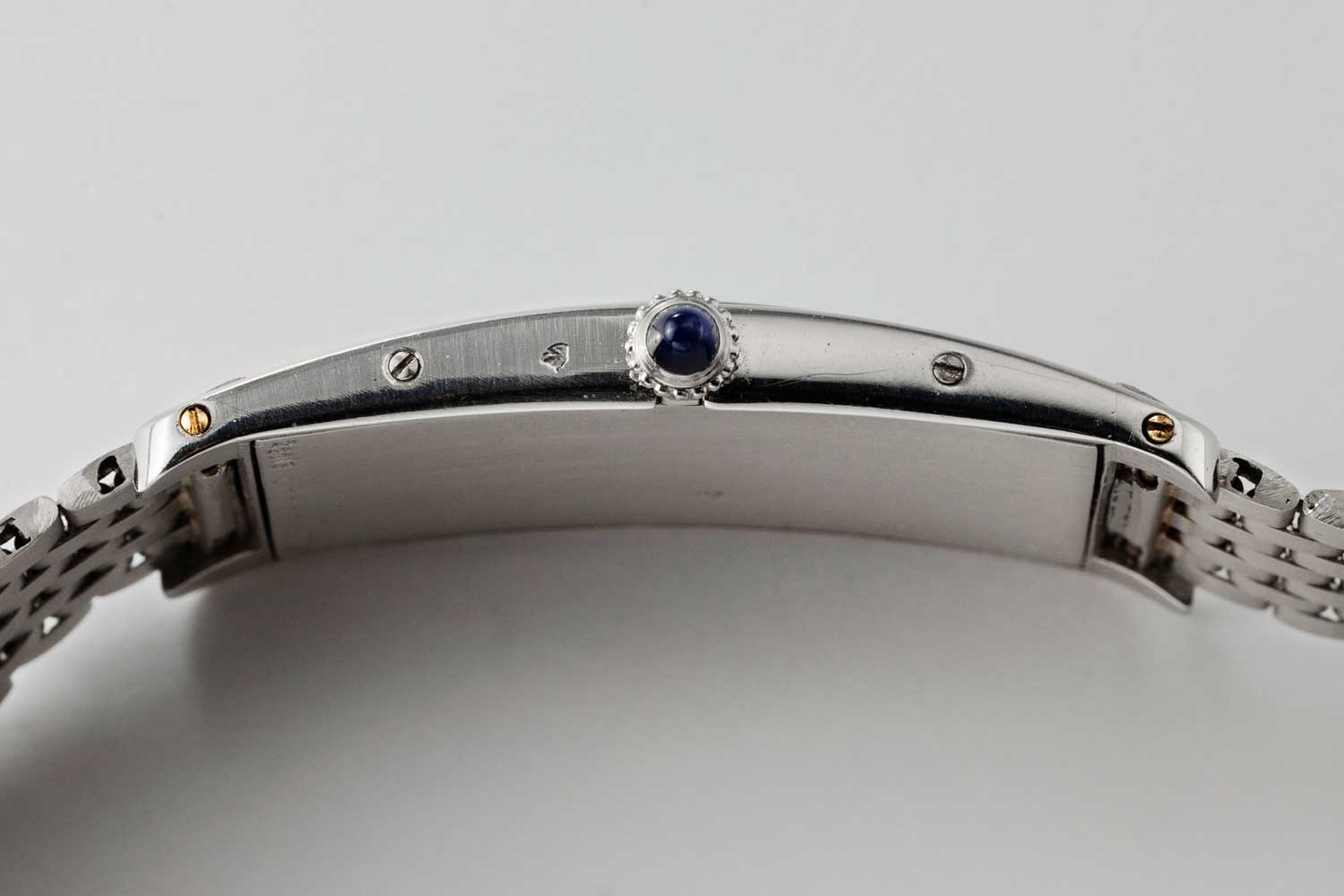
She will try to guide you to something unique and that really expresses the codes of Cartier in a beautiful way. Then your idea will be communicated to Paris. At this stage, Pierre Rainero will actually read the proposal to get an understanding of how well it fits Cartier’s values. For example, I had at one point requested a titanium Crash watch, but the response was that this metal would not be suitable for a Crash and I had to agree. I was trying my luck but what they explained made sense to me.
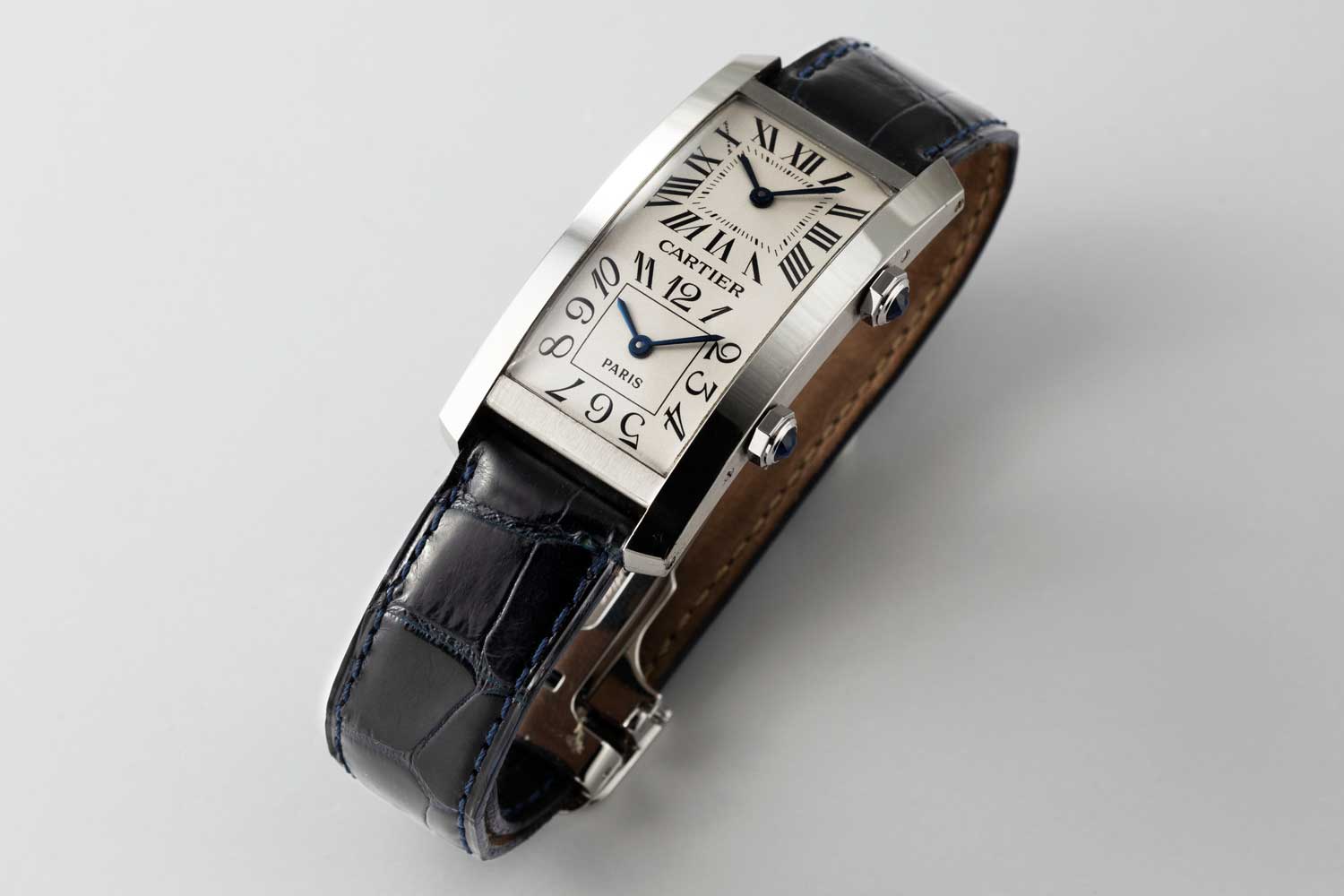
1996 No. 1/1 Cartier Paris Tank Cintrée in platinum with faceted sapphire-set winding-crown; double white gold dial with Roman chapters for home time and Arabic numerals for local time, blued steel "glaive" hands; two rhodium plated 6 3/4"' two movements, Cartier Caliber 067; this particular example is from the private collection of Auro Montanari (©Revolution)
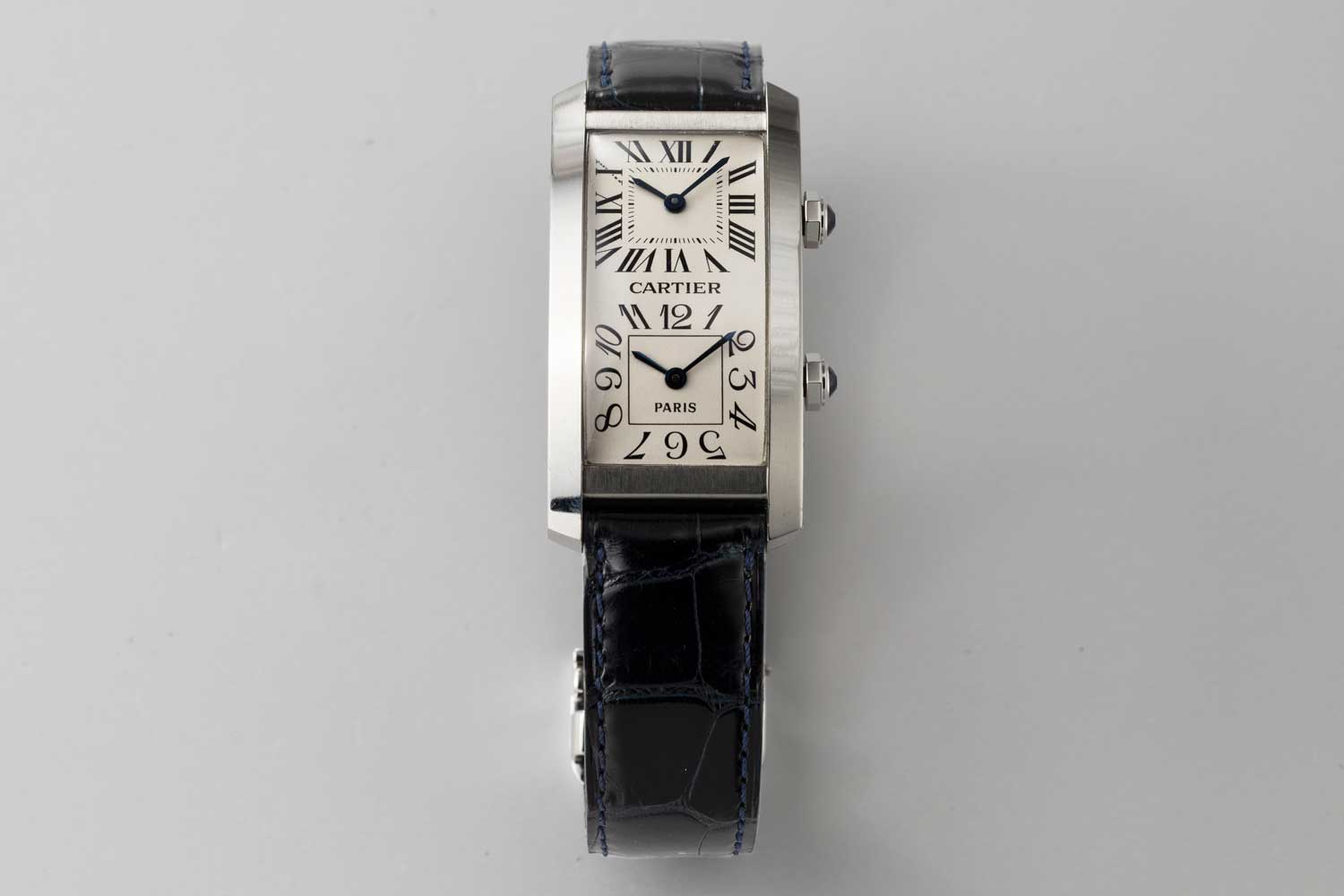
1996 No. 1/1 Cartier Paris Tank Cintrée in platinum with faceted sapphire-set winding-crown; double white gold dial with Roman chapters for home time and Arabic numerals for local time, blued steel "glaive" hands; two rhodium plated 6 3/4"' two movements, Cartier Caliber 067; this particular example is from the private collection of Auro Montanari (©Revolution)
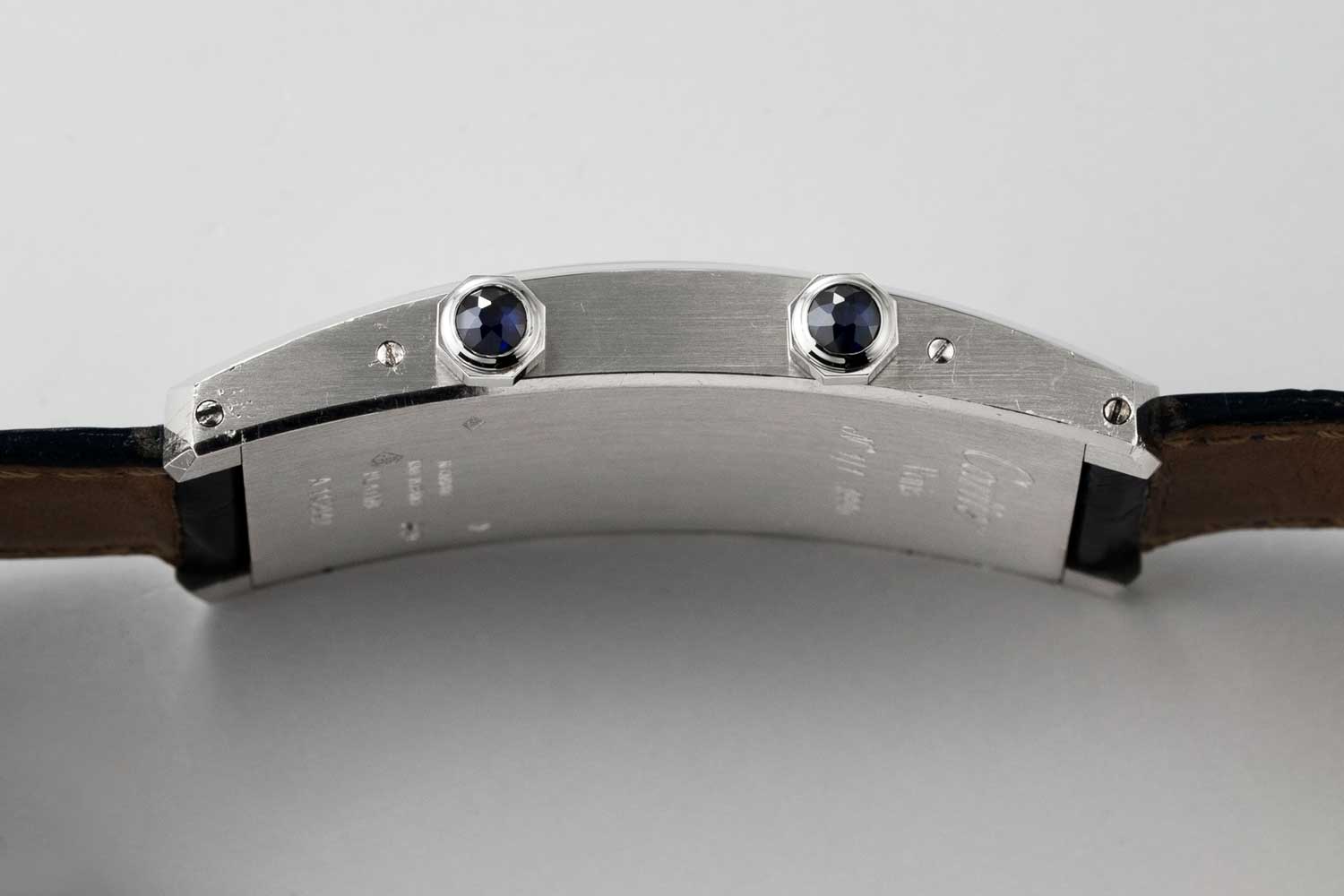
1929 platinum Cartier Paris Tank Cintrée with European Watch movement; In the middle of the 1990s a special order was made with Paris for a new blue dial with white Roman numerals, ie the dial placed in the case at the moment is not the same one from 1929; this particular example is from the private collection of Auro Montanari (©Revolution)
Finally, I decided on gray sword-shaped hands which gave the timepiece an appealingly modern emotional quality. The watch came on a burgundy alligator strap, but I’ve since swapped it out to a lizard strap in the same hue, made by my friend Federico De Peppo, a wonderful couture trained craftsman. His company, Huitcinq1988, makes some of my favorite leather accessories and watch straps. Every one of Huitcinq1988’s straps is made entirely by him from beginning to end, which I find very charming.
So, in the words of Sean Connery in The Untouchables, “Here endeth the lesson.” One thing for certain is that Cartier is on a major rise and the Tank Cintrée which celebrates its 100th anniversary this year is one of its most significant icons. I hope you enjoyed reading this as much as I enjoyed writing it. Stay tuned for much more Cartier content to come!










